MARIANI’S
April 3,
2011
NEWSLETTER
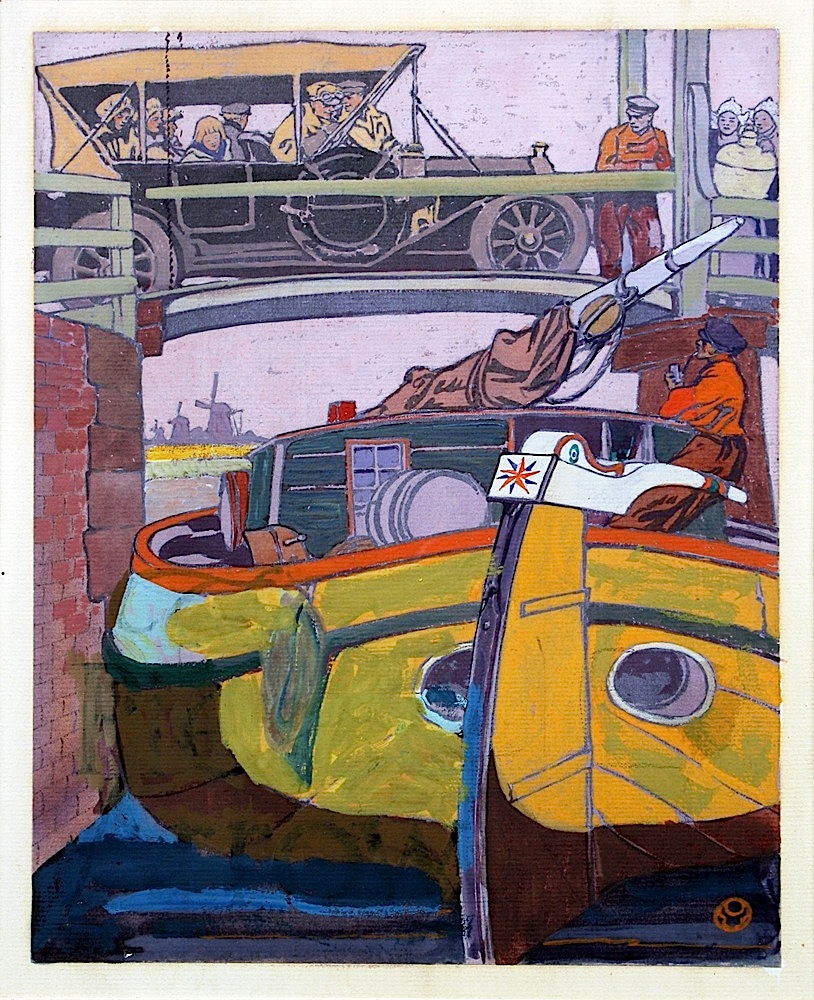
The
Barge Bridge by Edward Penfield (circa 1899)
by Edward Brivio
by
John
Mariani
by
Christopher Mariani
by
John
Mariani
❖❖❖
GOOD
NEWS! Esquire.com now
has
a
new
food
section
called
"Eat
Like
a
Man,"
which
will
be
featuring
restaurant
articles
by
John
Mariani
and
others
from
around
the
USA.
THIS
WEEK: A
Paean
to
Wonder
Bread
at
90
Years Old
Appearances

★ APRIL
6: John
Mariani will be appearing (re-scheduled)
on the "Morning Joe"
MSNBC-TV
Show on
Wednesday, to talk about his new
book How
Italian Food Conquered the World.
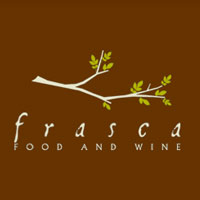
★ APRIL 7: Book signing and dinner with John
Mariani at Frasca in
Boulder, CO.
Call
303-442-6966,
with Master
Sommelier Bobby Stuckey, 2011 James
Beard Foundation
Award nominee for Outstanding Wine Service
Chef Lachlan
Mackinnon
Patterson, 2008 James Beard Foundation
Award
winner, Best Chef: Southwest. $100 per person.
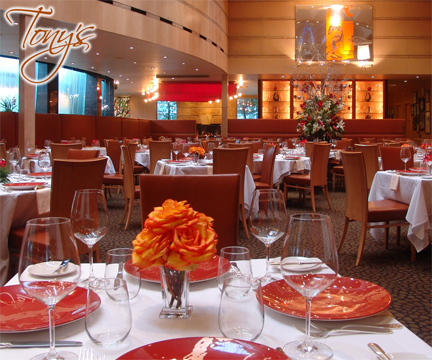
★
APRIL 13: Book signing and dinner with John
Mariani
at Tony's
in Houston.
Call
713-622-6778, with Tony Vallone.
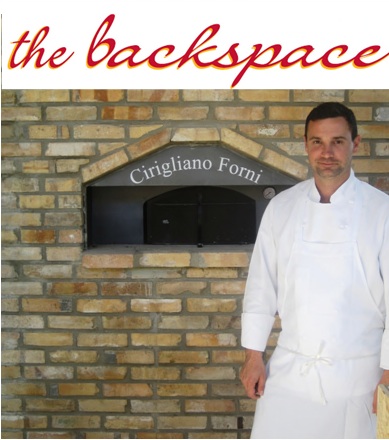
★ APRIL
15: Book signing and Italian fare at Shawn Cirkiel's
Backspace.
Call
512-474-9899. From 5-7:30 PM.
AND
A
VISIT
TO
NORMANDY
Photos (marked RP)
by
Robert Pirillo
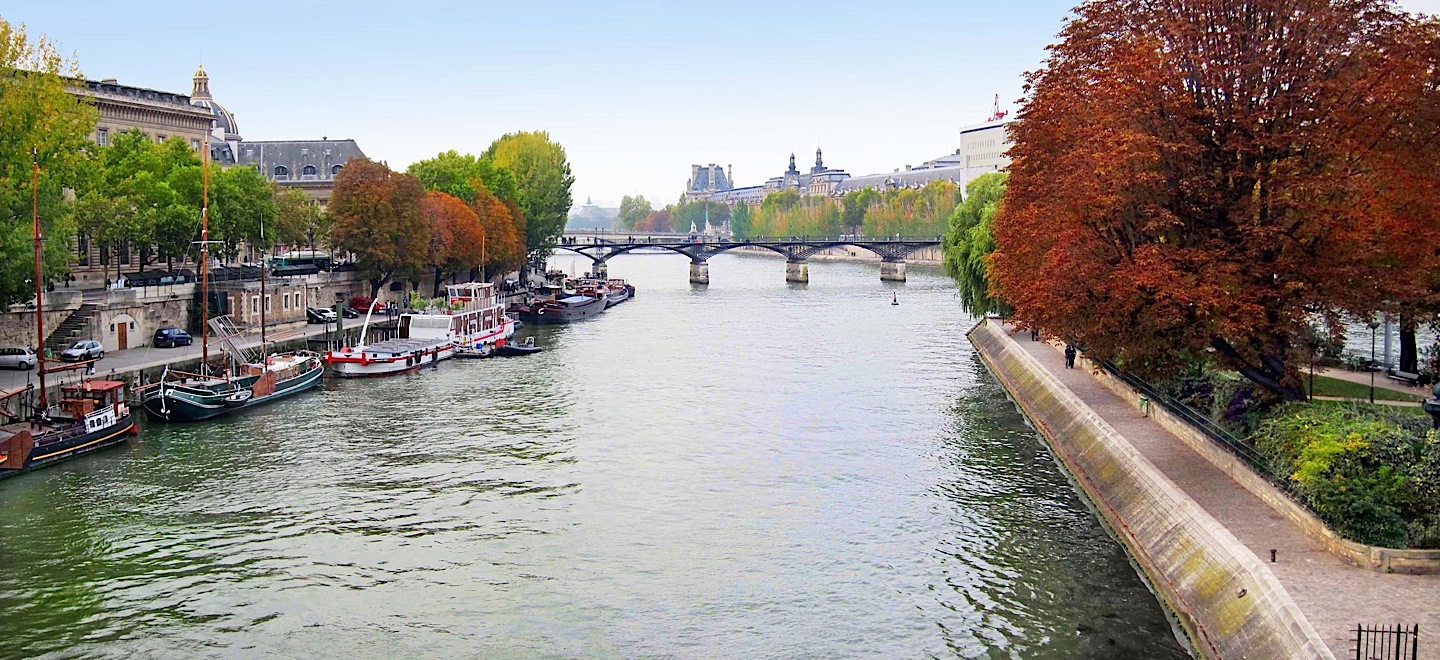
RP
Eleven days of dining in Paris has only left me longing for more.
The euro is still very strong, but even more so than Rome, the French capital is packed with good, modest restaurants where dinner for two need not require suspending a mortgage payment. Of course, don’t expect bevies of waiters in designer tuxedos in these local restaurants or sweeping views of the Seine, or gilded dining rooms from the 18th century. Nor will you find chefs who are household names or a cuisine that is as much intellectual as it is gustatory.
Small, unpretentious, usually crowded with a convivial mix of neighborhood regulars and savvy tourists, with one person in the kitchen, and another, le patron perhaps, in the dining room, these restaurants offer not only some of the best food you’ll eat anywhere at reasonable prices but a sincere smile, warm reception, and attentive, personal service as well. One is as much guest as client.
You are in Paris, however, the
birthplace, and
world-capital of haute
cuisine, so at least one good splurge is in
order.
Here are some of my favorites, based on a recent
return to the City of
Lights. (Dinner tabs throughout
this article incl.
tax, service, and wine.)
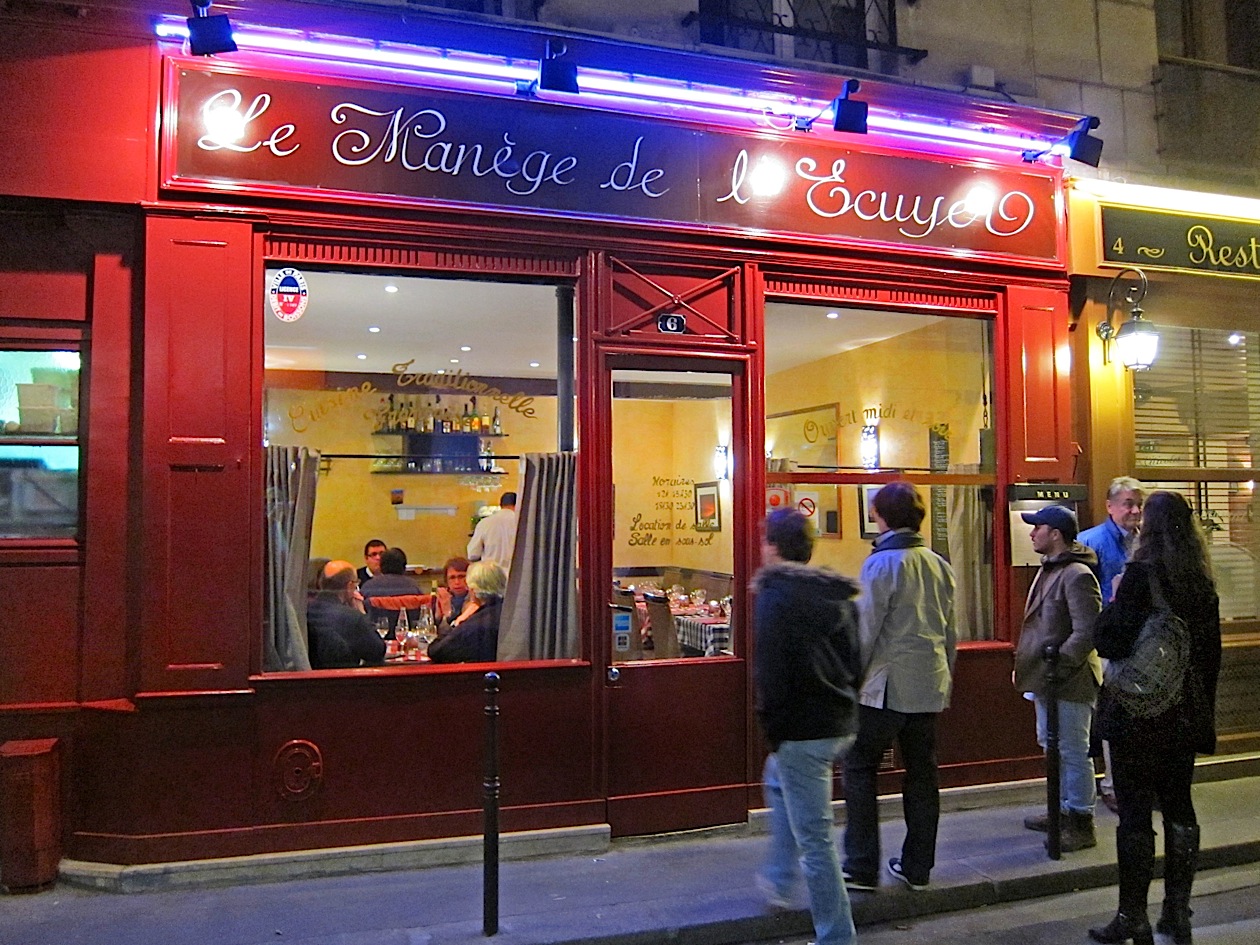 Le
Manège de
l’Écuyer (6 rue de
la Sourdiere, 2e, 01 49 27 00 64) Unable
to get a table at
our first choice one night, La
Cordonnerie (see below), I asked the chef
where in the
neighborhood would he
recommend? He sent us to ta place that we found
out
later is
also owned by him, but with its own chef. Le
Manège
is a bright, 20-seat storefront, with very
comfortable,
high-backed
wicker chairs, black gingham tablecloths, and a single
waiter in the
front of
the house. The night’s offerings appear on a
blackboard.
Le
Manège de
l’Écuyer (6 rue de
la Sourdiere, 2e, 01 49 27 00 64) Unable
to get a table at
our first choice one night, La
Cordonnerie (see below), I asked the chef
where in the
neighborhood would he
recommend? He sent us to ta place that we found
out
later is
also owned by him, but with its own chef. Le
Manège
is a bright, 20-seat storefront, with very
comfortable,
high-backed
wicker chairs, black gingham tablecloths, and a single
waiter in the
front of
the house. The night’s offerings appear on a
blackboard.
[RP]
I couldn’t have asked for better than my aumôniére de fromage, a “beggar’s purse” of puff pastry with a molten center of Gruyère, and a thick round of foie gras was very welcome, with its accompaniment of coarse-grained, whole wheat bread, and the small, perfectly dressed salad that seemed to garnish the plates in so many of the restaurants here. For the main course, we had wonderful confit de canard, which, as you‘ll read, we could never get enough of, and a classic côte de boeuf au Roquefort, or rib-eye with Roquefort sauce. Both came with a potato cake and a cake of potimarron--the winter squash, very much like a pumpkin (potiron), and very popular in Parisian cuisine--that was extraordinary.
Thank God I asked the waiter what was the delicious looking dessert the lady at the next table had ordered, for it turned out to be simply the best tiramisù I’ve ever eaten.
La
Cordonnerie
(27 rue St.-Roch, 2e, 01
42 60 17 42.),
with
two
small
dining 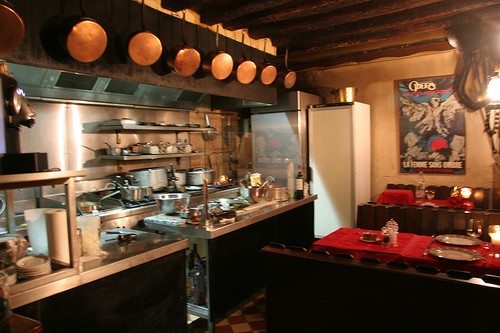 rooms
seating
maybe 20 people, is the market-driven,
chef-centric restaurant
since 1964--it's name means "the shoemaker"--that is
the stuff of gourmets' dreams. The front room, where
you enter, has
only two or
three tables. The rest of the space is taken up by a
large open
kitchen, filled
with well-used pots and pans, stoves, a refrigerator,
some counter
space, and a
single chef hard at work, shaking sauté pans,
checking what's in
the oven,
chopping a bunch of parsley, whipping cream with a
balloon whisk, all
with a
quiet grace and relaxed intensity that seems never
harried.
rooms
seating
maybe 20 people, is the market-driven,
chef-centric restaurant
since 1964--it's name means "the shoemaker"--that is
the stuff of gourmets' dreams. The front room, where
you enter, has
only two or
three tables. The rest of the space is taken up by a
large open
kitchen, filled
with well-used pots and pans, stoves, a refrigerator,
some counter
space, and a
single chef hard at work, shaking sauté pans,
checking what's in
the oven,
chopping a bunch of parsley, whipping cream with a
balloon whisk, all
with a
quiet grace and relaxed intensity that seems never
harried.
What comes out of this kitchen is extraordinary, unquestionably prepared à la minute, with the personal touch and attention to detail that only a chef who actually cooks in his kitchen every night can provide. This is as far as you can get from an “executive chef,” who may have nothing to do with the preparation of your meal, and even further from those absentee, celebrity chefs who fly in only occasionally to the numerous properties that carry their name.
As with all the restaurants in this article, reservations are essential, yet, fortunately easy to get. When we walked in to La Cordonnerie on our first night in Paris, only to be told that it was “complet.” “Could we come back tomorrow?” we asked, and of course we did.
Foie gras with a very light sprinkling of cocoa was a surprisingly delicious combination, while andouille de Guémené, a smoked pork sausage from Brittany, was served warm with pommes à l’huile, potatoes cooked in oil, that really were its perfect counterpart.
For plats principaux, we had an exceptional escalope de veau normande, sauce au calvados et frites, a substantial veal cutlet, more like a veal steak, beautifully browned and tender, in a pool of brown sauce enriched with cream and a hint of Calvados, that was truly delicious. And then there were the frites! “Fries,“ how can such a banal monosyllable be used for those served here? Hand cut, on the longish side, their nothing-special appearance masked the perfect fried potato, with a crunchy skin and a creamy inside. The well-traveled lady at the next table left almost all of her frites, and it took all my self-control not to ask her for them.
My main course was a cabillaud aux saveurs douces, douces not as in “sweet,” but as in “mild.” Nicely caramelized, and subtly, very mildly, flavored with cinnamon, cumin and other spices, the obviously super-fresh cod found perfect accessories in white rice, and diced fennel cooked in a very light cream sauce. Everything toned down so as not to overpower the clean, delicate flavor of the fish.
A very generous cheese plate, with 4 large, ripe wedges: Roquefort, Camembert, Tomme de Savoie, and Époisses, all chambres--brought to room temperature--finished the meal, as did fresh raspberries in a superb sabayon, topped with whipped cream.
Starters:
5.5 to 8.9
euros, entrees: 15 to 20, desserts: 6.5 to 9. Dinner
for two, 109
euros.
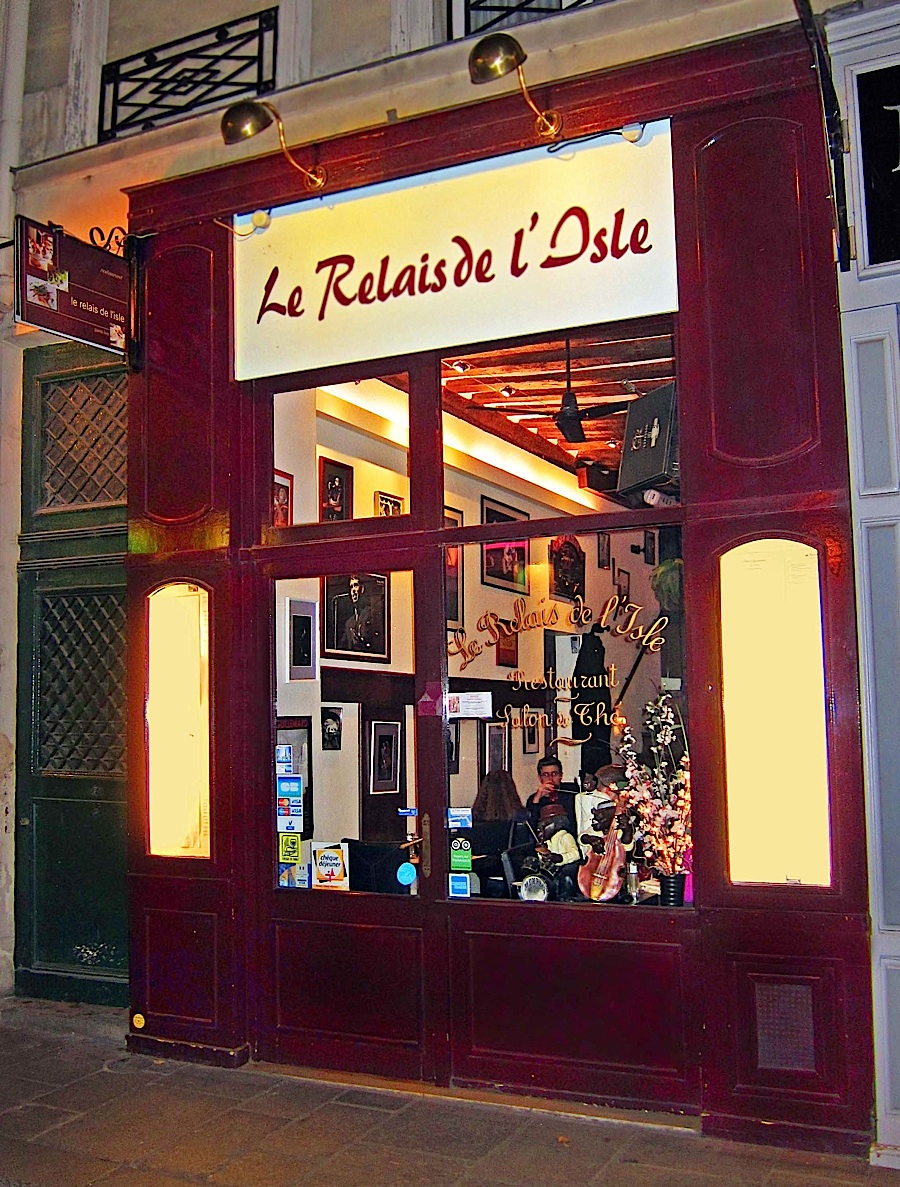 Located on the main street of the implausibly lovely
Île
St.-Louis, Le
Relais de l’Isle
(37 rue St. Louis en
l’Ile, 01 46 34
72 34) offers
perfectly executed,
classic French
cuisine in a narrow
room whose
walls are covered with framed b/w photographs of jazz
musicians. La patronne
serves as the lone waitress, and, given that each
order calls for a
trip up and
down a flight of stairs to the kitchen on the second
floor, she does an
admirable job. The warmth of her welcome, and the
careful attention she
gives
to each table’s needs come from more than
professionalism, they come
from the
heart, as does the playing of the pianist who spins
out beautiful
medleys of
jazz standards each evening, at just the right tempo
and tenor.
Located on the main street of the implausibly lovely
Île
St.-Louis, Le
Relais de l’Isle
(37 rue St. Louis en
l’Ile, 01 46 34
72 34) offers
perfectly executed,
classic French
cuisine in a narrow
room whose
walls are covered with framed b/w photographs of jazz
musicians. La patronne
serves as the lone waitress, and, given that each
order calls for a
trip up and
down a flight of stairs to the kitchen on the second
floor, she does an
admirable job. The warmth of her welcome, and the
careful attention she
gives
to each table’s needs come from more than
professionalism, they come
from the
heart, as does the playing of the pianist who spins
out beautiful
medleys of
jazz standards each evening, at just the right tempo
and tenor.
Dinner began with a round of chèvre, warm from the oven, atop a small green salad, and a duo of foie gras dishes--cooked mi-cuit, and pan-fried, poêlé --a large portion--with a fricassée of girolles et cèpes), slices of toasted baguette, and salad. Then a beautifully burnished roast partridge, perdreau rôti, a whole bird cut in quarters, with girolles, in a pool of dark, rich vigneronne sauce based on red wine, and a puree of salsify. I enjoyed filet de boeuf, a large hunk of tenderloin with a classic sauce Bêarnaise, rich with tarragon, served with hand-cut fries, and a mesclun salad.
Starters:
9 to 19 euros, plats
principaux: 21 to 29, desserts: 9 to 11. Menu
dégustation:
50 euros for 5 courses. [RP]
Le
Trumilou (84 Quai de
l’Hotel de
Ville, 01 42 77 63 98)
is an
old standby that 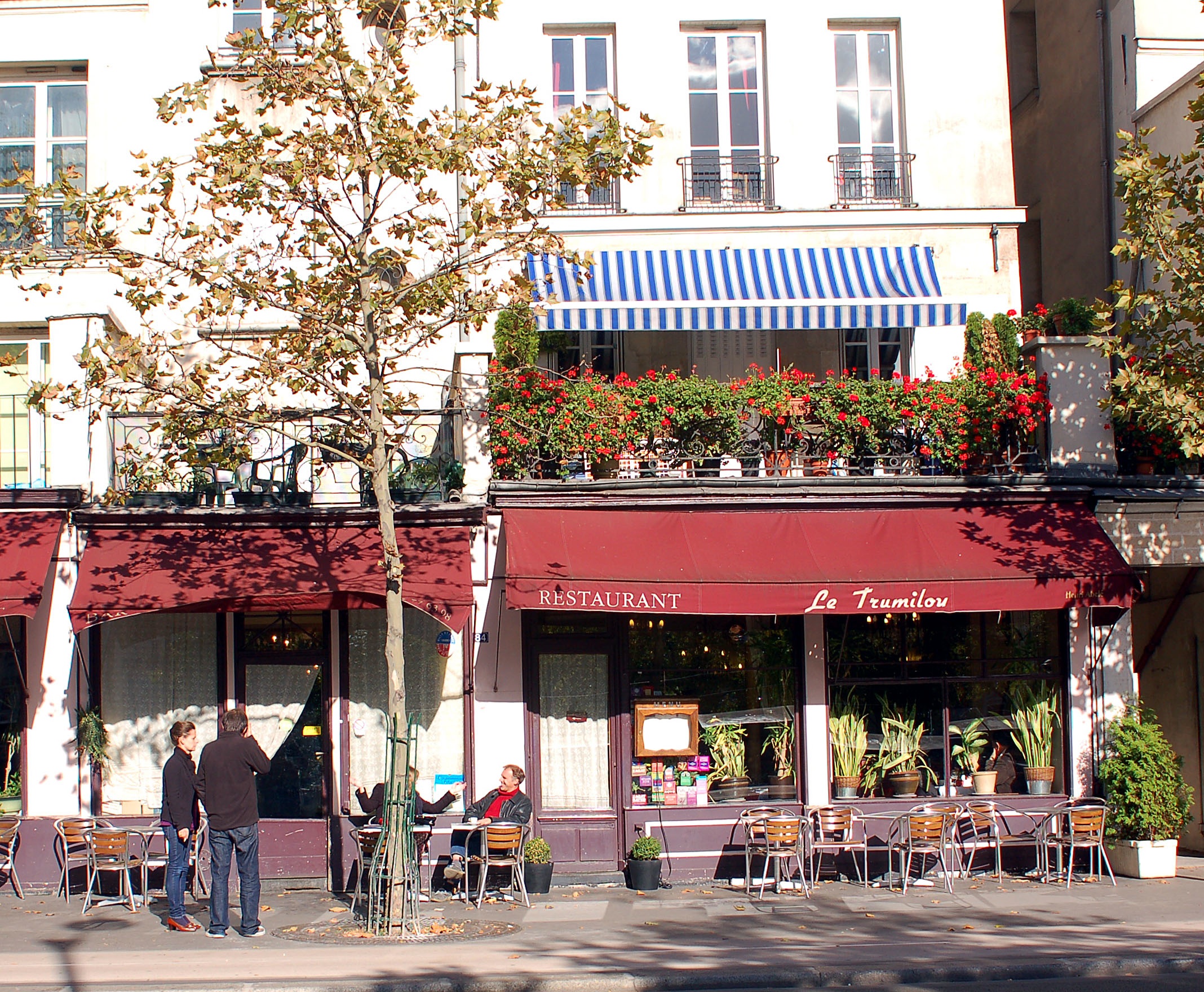 remains as
good, and as reasonable, as ever. A huge
frisée
salad chock full of yummy lardons and topped with
a perfectly
poached
egg, and saucisson chaud de Lyon
with wonderful pommes
de
terre
a
l'huile,
and a
crock of good grainy mustard, were followed
by
disappointing riz
de veau grand’mere, good flavor, but a
little
rubbery. The chef, I suppose, might have bypassed the
admittedly
involved,
preliminary
preparation of sweetbreads necessary to ensure that
the finished
product has
just the right texture. My partner adroitly filleted a
whole, grilled
sole that
could not have been fresher or more delicious.
remains as
good, and as reasonable, as ever. A huge
frisée
salad chock full of yummy lardons and topped with
a perfectly
poached
egg, and saucisson chaud de Lyon
with wonderful pommes
de
terre
a
l'huile,
and a
crock of good grainy mustard, were followed
by
disappointing riz
de veau grand’mere, good flavor, but a
little
rubbery. The chef, I suppose, might have bypassed the
admittedly
involved,
preliminary
preparation of sweetbreads necessary to ensure that
the finished
product has
just the right texture. My partner adroitly filleted a
whole, grilled
sole that
could not have been fresher or more delicious.
An
exemplary Île
flottante,
the ball of meringue firmed-up, but
not stiff, the crème
anglaise flavorful
yet
ethereal,
and made even
more scrumptious by the lightly browned crust on the
meringue,
the
whole thing rich and satisfying yet light as a
feather, as
insubstantial as a
breath. It’s
a classic dessert
but one too often treated with smiling condescension.
Here, a skillful
chef has
once again demonstrated why this bagatelle,
redolent of the
age of the boulevardiers,
continues to show-up on some very
high-end menus. Of
course, its appearance at a critical moment in the
1957 movie "Desk
Set"--a
Tracy/Hepburn vehicle-- hasn’t hurt either.
[RP]
Starters:
4.
to 14
euros, plats
principaux: 15 to 22, desserts: 4.5 to 7.
Prix-fixe menu:
19.5 euros, dinner for two, 89 euros.
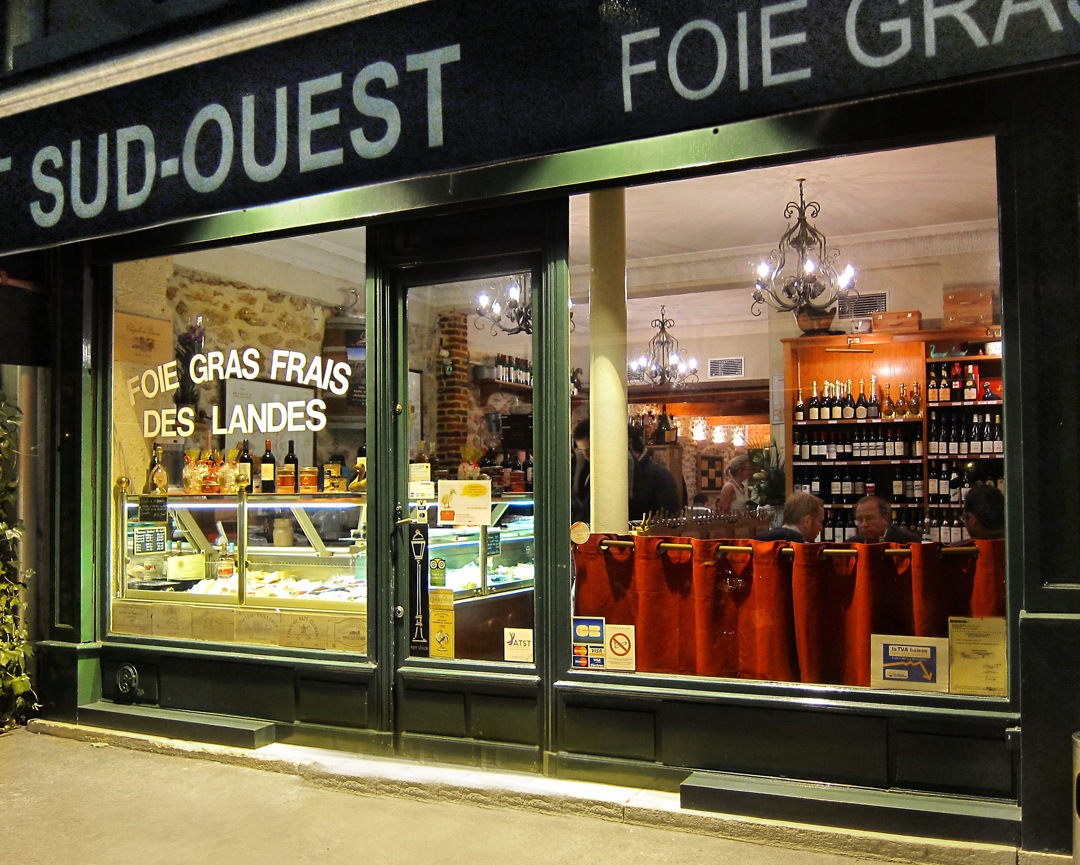 Au
Petit Sud-Ouest (46 Avenue de
la
Bourdonnais, 7e, 01 45 55 59 59)
is in
a storefront that is actually a store. The front
dining
room is a
delicatessen, complete with butcher’s display case
filled with cheeses
and charcuterie
on the left, and, opposite, walls of shelves stocked
with cans of just
about
everything you can make from a duck or goose: foie gras, confit,
cassoulet, maigret, and so on, as
well
as
a
large
selection
of
well-priced
wines.
Au
Petit Sud-Ouest (46 Avenue de
la
Bourdonnais, 7e, 01 45 55 59 59)
is in
a storefront that is actually a store. The front
dining
room is a
delicatessen, complete with butcher’s display case
filled with cheeses
and charcuterie
on the left, and, opposite, walls of shelves stocked
with cans of just
about
everything you can make from a duck or goose: foie gras, confit,
cassoulet, maigret, and so on, as
well
as
a
large
selection
of
well-priced
wines.
You
know you’re
someplace where the pleasure of dining is taken
seriously, when you
notice each
table has its own toaster. They understand here that
cold toast is an
oxymoron;
good foie
gras deserves
better. Order exactly how much you want (a great idea)
either duck or
goose,
either au torchon
or pan-fried, from 50 grams, for one
person,
up to 325 grams, recommended for 4 to 5 diners. 50 grams of
each was as usual most welcome. Confit
de canard with
potatoes and cèpes
followed next
--perhaps the best confit
that we tasted in Paris, with crisp skin and
tender flesh--
and blanquette
de
veau, which was perhaps a little bland.
There
was nothing to fault, however, about the assiette
de fromages
that
we
had
in
lieu
of
dessert.
Wedges
of Ossau-Iraty,
a sheep’s
milk
cheese from the Pyrenées, a veritable
Brie de Meaux,
and a Tomme
de chèvre, a semi-soft cheese made from
goat’s milk, all
perfectly affinés,
were especially good with warm toast. [RP]
Here
again,
Monsieur
and
Madame
who
run
the
place
provide a warm welcome as well as attentive
service.
By our second visit, we
had “our
table” and felt like members of the family. This
is the place to
stock up on foie
gras and confit to carry
back home
with you.
We certainly did. Just be sure to declare it; we
didn’t.
By the way, Au Petit
Sud-Ouest is a
five-minute walk from the Eiffel Tower. Schedule well,
and you can
finish
dinner just in time to catch the Tower’s spectacular
light show which
happens
after dark, every hour on the hour, for 5 minutes. I
wonder if
Parisians are
“over it.“ For visitors, each time is a treat,
especially close
up.
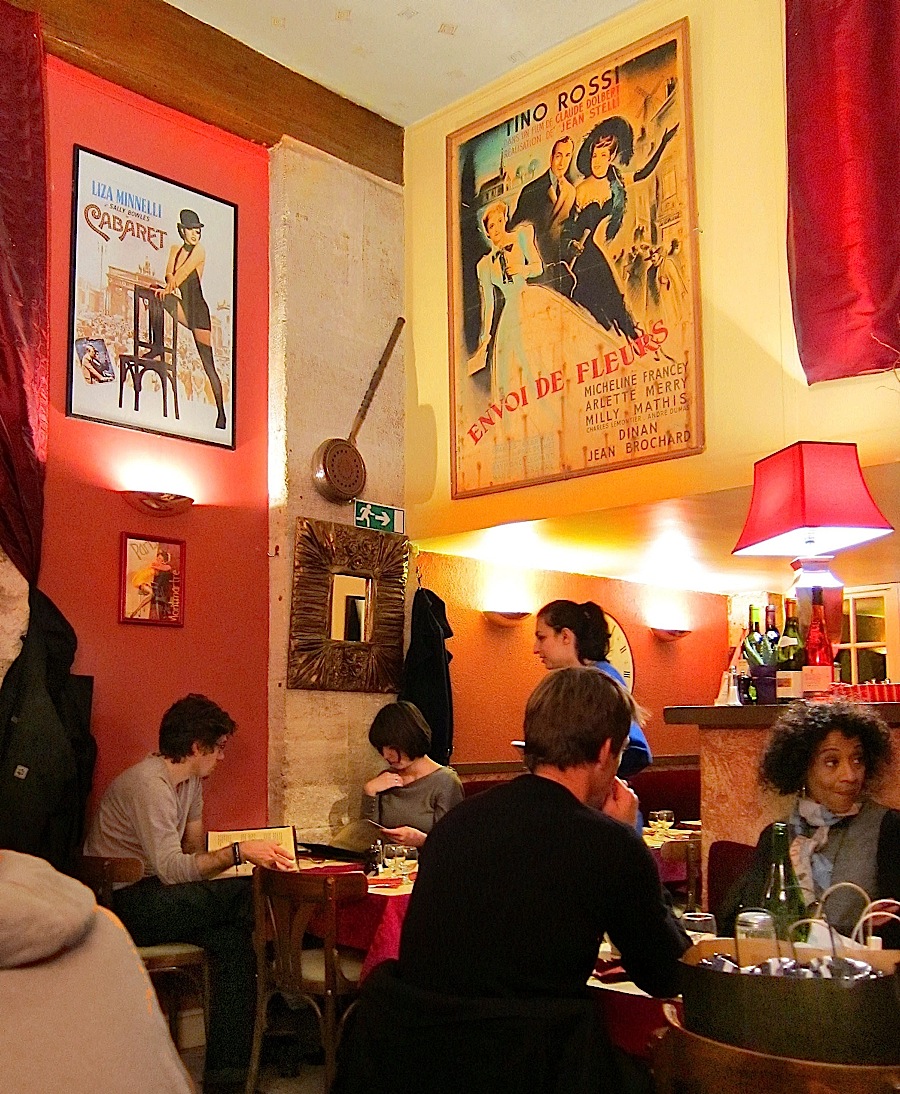
Café
Med (77
rue St.
Louis en l’Ile, 01 43 28 73 17; left) was
certainly the
biggest bargain on the
list, and we managed to get in without a reservation.
Here again, a
simple storefront façade opened onto a deep,
narrow rectangular
dining room--seating maybe 20 diners--with a high
ceiling, and a
handful of
large,
vintage movie posters on the walls for decoration. My favorite
was a large one for a film titled “Envoi
de fleurs,” starring Tino Rossi,
whose gorgeous tenor voice I just happened to discover
recently on You
Tube.
The clientele that night was
made up of families and young couples, all
French-speaking, and the
families
containing smiling young children up way past
what would be
considered
their proper bedtime in America, without any obvious
deleterious
effects on
either their health or their morals. We stuck to
basics, foie
gras to start, then
succulent
duck
confit,
with
half
a
bottle
of
Badoit and a pichet
of the excellent house wine,
and had a delightful meal. The two young
waitresses could not
have been
friendlier or more pleasant, and although space is
restricted, there
are a few
table that afford you privacy, and we were lucky
enough that night to
get one.
Our 3-course formule for 19.9 euros, and our total for dinner for 2 was 56.6 euros.
[RP]
And
finally,
two
neighborhood bistros for a quick bite. Both serve
dinner, but we were
only
there for lunch. Both had very tight seating, usually
packed with
diners, but
it was all somehow part of their Parisian charm. The
waiters must all
take
ballet, as well as a little gymnastics, the way they
navigate the
narrow
aisles, packed tray in hand. Le
Petit Marcel (65 rue
Rambuteau, 4e,
01 48 87 10 20) is right next to Beaubourg/Centre
Pompidou  on
a
bustling pedestrian thoroughfare (below).
Go
there
for
its
high
energy,
the
wry
smiles
of its friendly staff, and their fast, efficient
service. Go also for
the great confit de canard,
excellent frites,
grilled ham and
goat cheese on a slice of pain
Pôilane, or an excellent ham
and cheese
omelet, and good, reasonably-priced house wines.
Cash only. [RP]
on
a
bustling pedestrian thoroughfare (below).
Go
there
for
its
high
energy,
the
wry
smiles
of its friendly staff, and their fast, efficient
service. Go also for
the great confit de canard,
excellent frites,
grilled ham and
goat cheese on a slice of pain
Pôilane, or an excellent ham
and cheese
omelet, and good, reasonably-priced house wines.
Cash only. [RP]
Le
Louis IX (22 rue des
Deux Ponts,
4e, 01 43 54 23 89) is located on the
Île St. Louis. Try
the delicious
Normandy
oysters on the half shell with a racy mignonette sauce,
succulent mussels,
great frites,
a superb omelet of girolles,
and a
wonderful croque
delice, that is, a croque
monsieur sandwich with a fried egg on top
(an
altogether excellent idea) the ubiquitous small,
perfectly-dressed
salad, and
bargain pichets
of house wines, especially the
exceptional Brouilly,
as well as the only rude --really rude--waiter we
encountered in
Paris. A
blackboard displays the day’s specials.
For
that splurge, we headed
for Le Diane, the fine dining
restaurant of the Hotel
Fouquet’s
Barriere (46 Avenue Georges V),
right
off
the
Champs-Élysées, which
echoes, on a
smaller scale, the latter’s chic, understated,
up-to-the-minute
elegance.
Designed as a temple to haute cuisine,
the
rotunda-like
dining
room,
all
in
cream
and
gold,
is at once imposing and dramatic, yet intimate
and serene.
Trios of niches filled with tall vases of flowers, a
large,
velvet-upholstered,
circular settee in the middle, and the tufted cupola
provide the drama,
while
tall, intricate, leafy, gilt- bronze torchères
--
as much ancien
régime as 21th Century -- deliver the
soft, muted lighting
which
gives the
space its warmth. Widely-spaced tables allow for
privacy, and are set
with fine
china, crystal, silverware, and immaculate
napery.
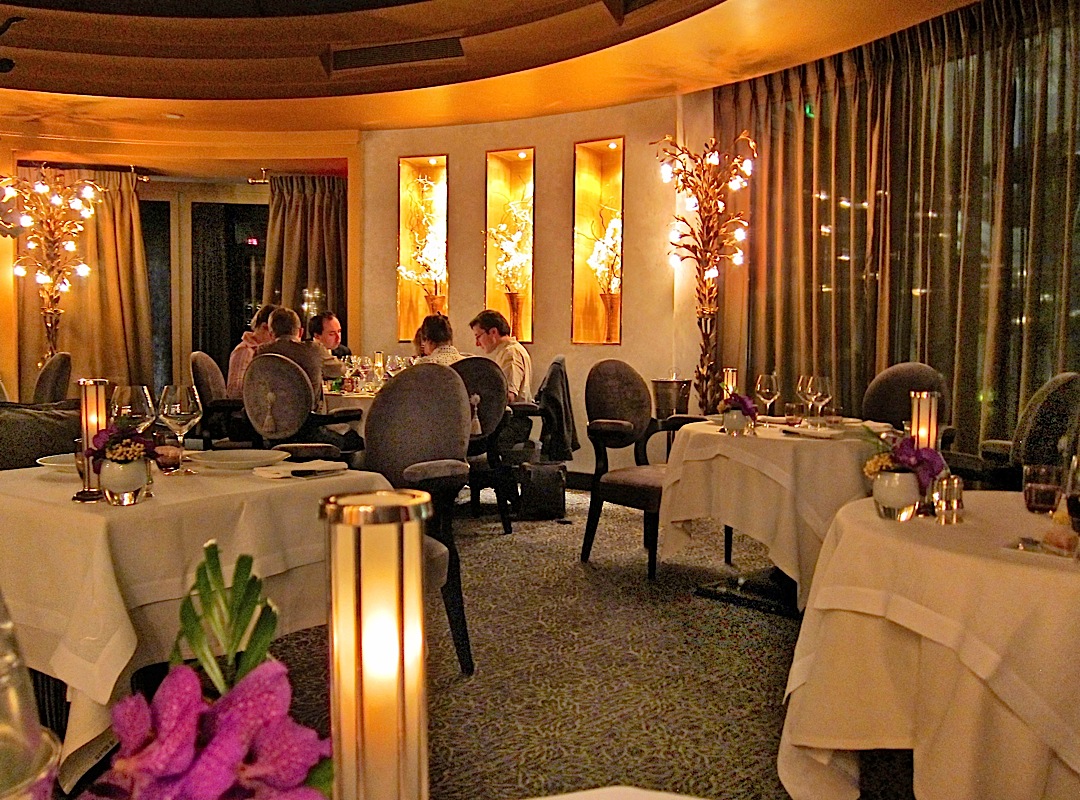 Service
was
provided
by
a
maître
d’,
a
waiter,
and a busboy, all elegantly
turned out, who performed their tasks with smooth,
quiet efficiency.
Plates
came and went unobtrusively, and the
servers
seemed to move on those proverbial “little cat’s
feet.” Formal, but sans
hauteur, courtly, but sans snobisme,
and
actually seeming to enjoy their work while still
maintaining the room’s
air
of posh, yet comfortable exclusivity, they were as
much a part of the
spell Le
Diane cast as its dramatic layout, chic
décor, warm
lighting, and
world-class cuisine. For
the duration of the
meal, at least, we too were among “the happy few.”
Service
was
provided
by
a
maître
d’,
a
waiter,
and a busboy, all elegantly
turned out, who performed their tasks with smooth,
quiet efficiency.
Plates
came and went unobtrusively, and the
servers
seemed to move on those proverbial “little cat’s
feet.” Formal, but sans
hauteur, courtly, but sans snobisme,
and
actually seeming to enjoy their work while still
maintaining the room’s
air
of posh, yet comfortable exclusivity, they were as
much a part of the
spell Le
Diane cast as its dramatic layout, chic
décor, warm
lighting, and
world-class cuisine. For
the duration of the
meal, at least, we too were among “the happy few.”
[RP] A trio of shrimp preparations: grilled, in a dumpling, and tartare were served with two glasses of seafood broth, for dipping and drinking, and individual squeeze-tubes of wasabi, all beautifully presented on a hammered stainless rack, and delicious. For chef Jean-Yves Leuranguer (named "Meilleur Ouvrier de France" in 1996), sourcing the best ingredients (where better than in France, where every region, and, even, many of the individual towns, boast their own, high-quality, often exceptional, products) and treating each in the manner best suited to bring out and enhance its inherent goodness is just the start.
The arrangement of the plates must also be creative and inspired: mini-tableaus as lovely as they are mouth-watering. My salmon that night was mi-cuit, that is, cooked at a very low temperature for a relatively long time, so it’s definitely not raw, but the proteins have not been allowed to toughen. The fish, a deep, ruby red rectangle, was laid diagonally, across a square field of green, lime-flavored sauce, all enclosed in a white, four-sided frame of coconut sauce.
Precisely shaped, tiny pieces of red and yellow beets, were set into the frame like miniature jewels.
It
certainly
was
the
sweetest,
and
most
tender
salmon
I’ve
ever eaten, while the two sauces
and the
little nibbles of beet, added complementary flavors
and textures. For
the
line-caught sea bass,
bar de ligne,
the presentation was
simpler,
almost home-style. The visual 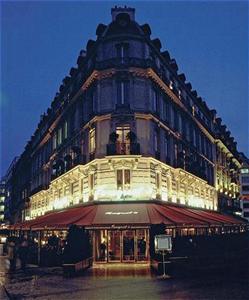 impact of the
piece of perfectly grilled,
beautifully fresh fish was enough. All it needed was a
bed of coco
paimpolais. What
kind of
coconut is that, you may well ask
yourself, as I
did when I saw it on the menu?
impact of the
piece of perfectly grilled,
beautifully fresh fish was enough. All it needed was a
bed of coco
paimpolais. What
kind of
coconut is that, you may well ask
yourself, as I
did when I saw it on the menu?
Well, live and learn. This is France, after all, whose gastronomy has just been awarded World Heritage status. Coco paimpolais, as it turns out, are white beans with red pods, larger than navy beans, oval, but verging on the circular, grown in Paimpol, a township in Brittany, whose specialty now carries its own AOC, the first given to a fresh vegetable. Plump, inviting, with a slight nuttiness all their own, they certainly were delicious beans.
A few small pieces of abalone, again from Brittany, atop the fish and a nage resembling sea-foam completed the tableau. Slices of milk-fed veal loin (veau de lait fermier), exactly medium rare, were simply laid out in a small puddle of delicious brown, demi-glace sauce, with a fondant potato “basket” filled with cèpes and a few baby, root vegetables the only other thing on the plate, each element brought to perfect fruition.
With dessert, the chef’s painterly whimsy was once again at the fore. Parfums de Thailande, turned out to be three prettily arranged scoops of gelato: lime, lemon verbena, and grapefruit, on a coconut wafer, with five dots of curry sauce flecked with gold leaf, and seven of lime finishing off the plate.
Fortunately, the night we were there, one of the tables around the central settee was occupied by a well-dressed couple, the woman dressed to the nines in a very dramatic black dress, and long above-the elbow, black gloves. Her dress --very like the one that Bette Davis wore in "All about Eve" at the infamous party--had an haute couture flair that was unmistakably contemporary. Not only beautiful, it also suited her own particular beauty, her coiffure, and her beautiful shoulders, as well as the zeitgeist, to a tee. All that was needed were the spectacular jewels (each substantial, but not flashy, and all, one would imagine, gifts from the man, her husband more than likely, sitting across the table) on her fingers (large emerald and ruby rings), her wrist (a tennis bracelet of good-size diamonds) and her ears (more big diamonds). I found it very hard to take my eyes off her. She was just what the space was about: elegance, luxury, wealth, and easy, exquisite good taste.
Appetizers:
23 to 49
euros, main courses: 42 - 62, desserts/fromage: 18
euros. Menu
gourmand:
78 euros, menu
dègustation: 98 euros, 125 with wines.
OFF TO NORMANDY
1899 at Les
Manoirs
de
Tourgeville.

[PG]
Hidden up a forest lane a few miles from Deauville and Honfleur is Les Manoirs de Tourgeville (Chemin de l’Orgueil, Tourgeville, 02-31-14-48-68; doubles from 130 euros, suites from 220), a rural, boutique hotel that brings a new standard of luxury to the countryside of Basse-Normandie. Sharing a lush, verdant tree-lined road with a dozen or so half-timbered manor houses, once farms, now carefully restored as country estates for gens de bien, Les Manoirs invite one to sit back, breath in the sweet country air, and stay a while, enjoying its superb accommodations and beautiful, peaceful surroundings. Only the setting is rustic; the elegance of its guestrooms is undeniable.
Our
suite
spread
over
three
floors,
a
large
living room on the
first floor, dressing room and marble bathroom on the
2nd, and
spacious bedroom,
with king-sized bed on the floor above. Everything was
fresh and brand
new. A
deep bathtub and rainfall shower head, luxury
toiletries, thick towels,
towel
heater, and fluffy bathrobes added to the amenities,
while the lovely
living
room had a small dining area, and boasted a manor
house-sized, working,
fireplace. The fire
was all ready to go
when we checked in, obviously assembled by someone who
knows how to
build one.
A single match did the trick. When our wood rack was
empty, we called
the front
desk, and more logs and tinder were promptly
delivered. (We even had a
fire
with breakfast.) Throw in a large, indoor, heated
swimming
pool, sauna, tennis court, rapid-fire room service
--the
quickest I’ve ever encountered--and a smiling,
personable, and helpful
staff, aux
petits soins,
as
the French would say, and you’ve got
everything
needed to make your stay a memorable one.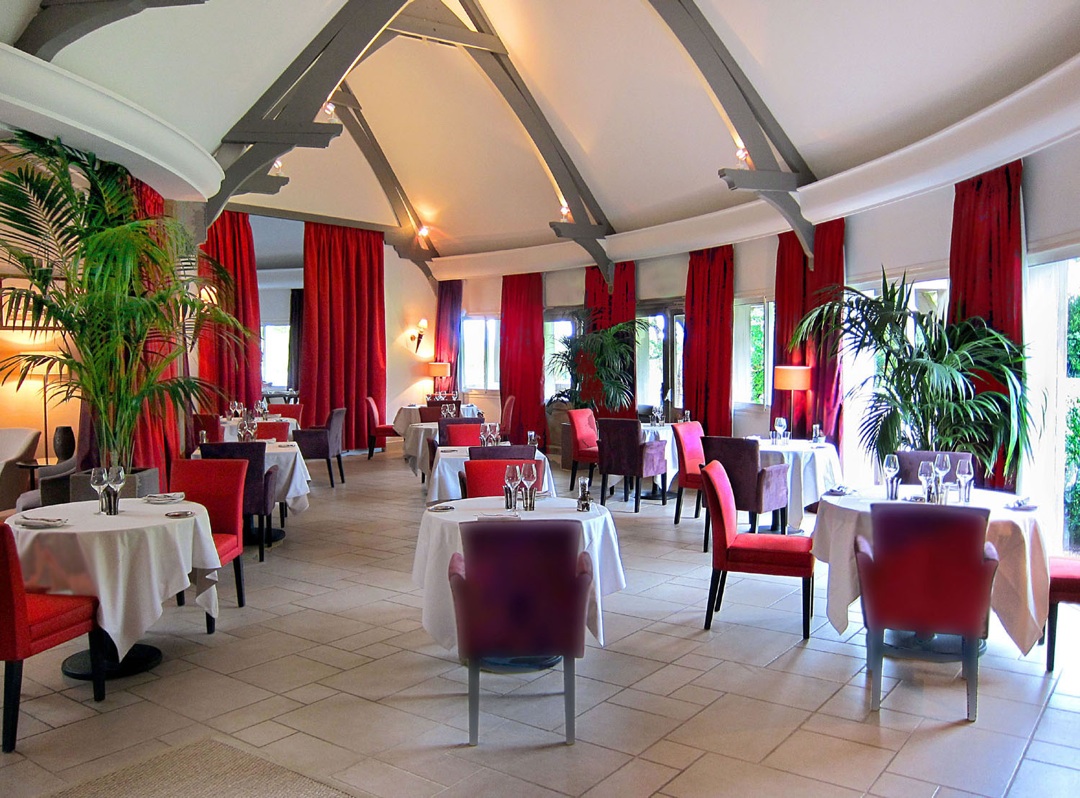
Plus, there’s Bernard, the soul of the place. Although he does help with the bags and fetch the firewood, to call him a bellboy would be ridiculous-- he looked to be in his fifties; factotum would be better, but majordomo would be the most accurate. He’s looked after guests at the property since long before its present incarnation. Called simply Club 13, then La Hostellerie de Tourgeville, it was a single building, 25-room, country gite, once owned by film director Claude Lelouch, of "Un homme et une femme" fame. Purchased by Groupe Floirat in 2009, it reopened as Les Manoirs in May, 2010, after nine months of major renovations including the addition of four new, round manor houses, all built, in a typically Norman style, for a total of 57 rooms. We were only there for two nights, but Bernard is, to say the least, a “quick study,” and, once having gauged our preferences, did his best --which is very good indeed-- to stay one step ahead of our requests. I felt honored, somehow, to be the recipient of his ministrations. [RP]
Basse-Normandie is as famous for racetracks as for its apples and beaches, and one part of the Manoirs’ grounds borders on a racehorse paddock containing (quartering, holding) about a dozen or so horses --adults, colts, and a few yearlings as well. The colts seemed to know that we were taking their pictures, as four of them lined up neatly abreast, as close as they could get to the camera from the other side of a wire fence, and even appeared to nod to let us know when they were ready for their close-ups.
The name of the restaurant here, 1899, is a tribute to the founder of Groupe Floirat, Sylvain Floirat, who was born in that year. Redesigned by local architect, Patrick Le Gosles, the dining room is a gorgeous, large, circular space, filled with light from panoramic floor-to-ceiling windows overlooking the grounds and woods beyond. Inside, drama is provided by the massive beams of Normandy oak, used as “ribs” for a spectacular cathedral-high, timbered-framed roof, constructed like an umbrella’s canopy. Like the rest of the property, its architectural charm resides in the use of traditional, local building materials --wood, ashlar stone and slate-- and of structural elements verging on the primitive --those large timbers could almost have been hewn with an axe, and the roof-pole and crown recall the yurts of nomadic shepherds-- but used in a new way, and with the addition of super-sophisticated details, all without sacrificing creature comforts. Tables are beautifully dressed, widely-spaced, and surrounded by comfortable chairs.
The chefs here need not look far for inspiration, and dinner began with two local specialties: foie gras de canard d’Auge, and poire Louise-Bonne, a winter pear from Avranches. The foie gras was served two ways, au torchon and pan-seared, alongside slices of the pear, both fresh and confit, as well as a pear chutney, an excellent combination of sweet and savory, hot and cold, and rich, buttery flavors and clean, crisp ones.
Next, presse
de pot
au feu de jarret de veau Normand, a
delicious terrine made
from a pot
au
feu of
veal knuckle
--with the meat and vegetables cut up, then
layered
under a weight (presse),
so
the
result
had
the
visual
precision
of
a
sand painting-- served with three thick drizzles of
horseradish sauce,
a mesclun salad, and a small pile of woodsy, autumn
mushrooms that
seemed
to
bring the surrounding woodlands inside. As
did demi perdreau
rouge de chasse, dorè en cocotte, an
entrée of
beautifully
burnished wild
partridge -- half a bird, a tiny drumstick and
thigh, and slices
of the
breast-- as well as toasted slices of baguette
lavishly
spread with a
deep, dark, delicious paste made from the liver, along
with a diamond
of
pumpkin flavored polenta and a verjus sauce. Just as
good as the wild bird was the farm-raised saumon
d’Isigny,
with
lemon-thyme and Romanesco.
As
did demi perdreau
rouge de chasse, dorè en cocotte, an
entrée of
beautifully
burnished wild
partridge -- half a bird, a tiny drumstick and
thigh, and slices
of the
breast-- as well as toasted slices of baguette
lavishly
spread with a
deep, dark, delicious paste made from the liver, along
with a diamond
of
pumpkin flavored polenta and a verjus sauce. Just as
good as the wild bird was the farm-raised saumon
d’Isigny,
with
lemon-thyme and Romanesco.
[RP]
From
a
new aquaculture
enterprise --the first fish were sold only in July of
last year-- in
Isigny-sur-mer in Calvados that uses no vegetable oil,
artificial
colorants, or
antibiotics, this was definitely high quality, firm
fleshed salmon (left),
with
a
delicious flavor and a blush of pink color. A streak
of lemon-thyme
sauce ran
around the periphery of the plate, studded with
beautiful pale green
flowerets
of Romanesco (not Romesco, as I had first
read), a type of
broccoli
(not a sauce), sometimes called Romanesco broccoli,
sometimes R.
cauliflower,
that looks like some outer space or undersea mutant of
a plant that’s
a
little bit of both vegetables. (For those interested,
it’s a fractal.)
Very
tasty
and very beautiful to look at, and with a much more
pleasant and
interesting taste than either broccoli or cauliflower.
Normandy’s endless bounty was again center stage with our assiette de fromages normande. Camembert, Livarot, and Pavé d’Auge, all served at the peak of ripeness, and with a small salad that was just what was needed to clean the palate between bites of cheese. The unpasteurized-milk Camembert, had a much worse bark than its bite, its flavor milder than its intense odor would lead one to expect, and Pave d’Auge is an old variation of Pont l’Evêque.
Dessert proper was coing et réglisse, a warm quince soufflé, with a licorice crème brûlée. I’ve never been partial to licorice, but I love quince, so I had to try it. I’m glad to say that the licorice was very subtle, and the quince very intense, just as I’d hoped.
We drank a delicious, reasonably priced red burgundy, a 2005 Château de Chamirey, Mercurey by Antonin Rodet, recommended by the sommelier. It was a classic expression of French pinot noir: a bright ruby red, with lovely cherry fruit without a hint of sweetness, a whiff of underbrush, a medium body, and a supple texture.
❖❖❖
Photos
by
Geert
Teuwen,
Iwan
Baan,
and
Evan
Sung
Lincoln Center
212-
359-6500

Few
restaurants
in
America--or
anywhere
for
that
matter--have
the
architectural sweep and beauty of Lincoln, the
showpiece Italian dining
spot at Lincoln Center. It is, in fact, the latest on
a tiny list of
grand NYC design marvels that include The Four
Seasons, Windows
on the World (sadly destroyed on 9/11), and The Modern
at the Museum of
Modern Art. Lincoln was done by Diller,
Scofidio + Renfro, which also did the High Line
trestle and NYC's
Waterfront Park, always creating designs that
partake of and
enhance the spaces they occupy. In the case of
Lincoln, it is a sloping
glass box with an actual NYC green park on its roof,
just now
attracting people for whom 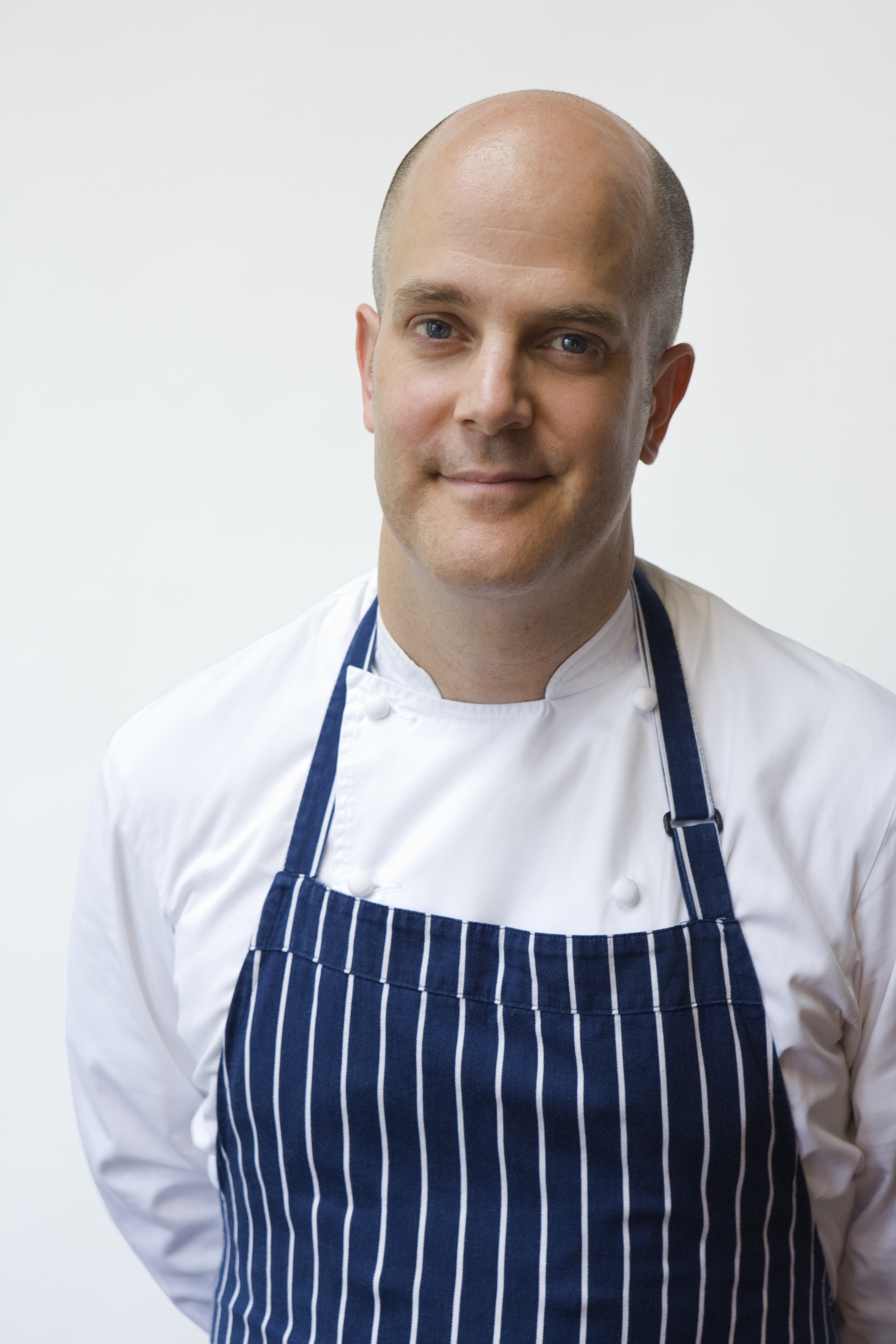 basking in the springtime
sun, flanked by Lincoln Center,
Juilliard, and the torrent of Broadway below is as
much thrilling as
soulful in a way that only NYC can convey.
basking in the springtime
sun, flanked by Lincoln Center,
Juilliard, and the torrent of Broadway below is as
much thrilling as
soulful in a way that only NYC can convey.
Right off the bat, here, I must
tell you that my son
is one of the managers at Lincoln, so I can hardly be
objective
about the service except to say that it definitely has
a NYC cast of
genial hospitality. Form your own conclusions.
The wine list, under Aaron
von
Rock, is all-Italian, with 350 selections of
mostly small
producers, with plenty of bottlings under $50.
The appointment of
master chef Jonathan
Benno (right)
by the Patina Group
(which also runs Sea Grill, Brasserie, and Fonda del
Sol in NYC) was
one of the most talked-about
of late 2010, since Benno had for many years
been chef at Thomas
Keller's Per Se, having previously worked at Keller's
French Laundry in
Napa Valley, and along the way been on brigades at
Aqua in San
Francisco, Daniel, Craft and Les
Celebrités in NYC, and
Auberge du Vieux Puits in France. Since Per Se
had won just about
every high star rating in the world and since Benno
was named in 2006 one of ten “Best
New Chefs” in the United States by Food & Wine
Magazine,
expectations were very high upon his taking over at
Lincoln. As
too often (always?) happens, NYC food critics leapt
to judgment and
found Lincoln something less than what they'd hoped
for in terms of
highly imaginative, highly personalized, Per Se-like
cuisine, with an
extensive tasting menu. The reviews were rarely
effusive but at least
some noted that Benno's strengths would prove
themselves as the kitchen
evolved. This has certainly been the case in
now illustrious
restaurants like Gramercy Tavern, Eleven Madison
Park, Del Posto,
Adour, and SD26, where within a few
months of opening, they achieved a balance and focus
that soon made
them
among the finest restaurants in NYC.
So, too, over several visits I
have seen Benno's
cuisine evolve, not by becoming more complex or
precious but by sheer
refinement and reconfiguring, so that some dishes
still on the menu
from the fall are now stellar examples of cucina italiana.
Newer dishes show
his finesse and insistence on deep, rich flavors
that come directly
from ingredients that need no manipulation.
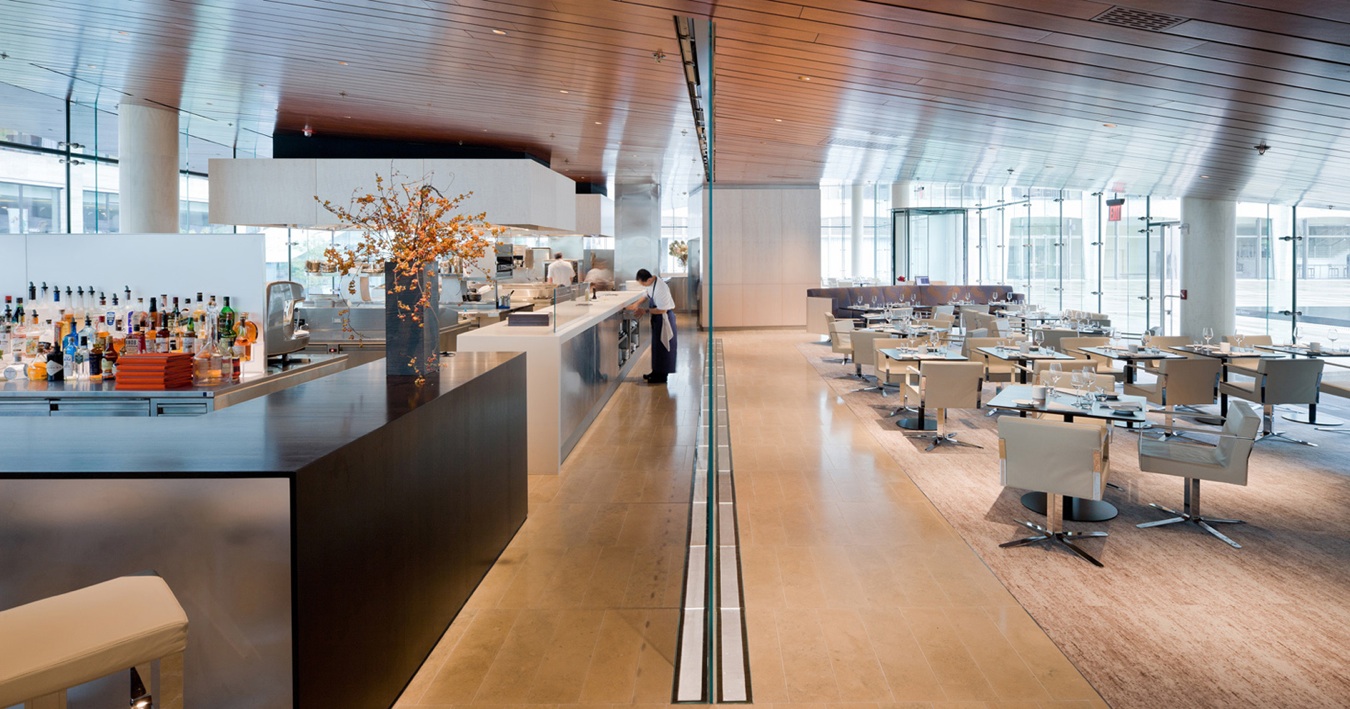 At
lunch
you
may
well
begin
with
a
simple salad of chicory and pecorino cheese
just to perk the appetite, the ingredients
revelatory of Benno's mania
for excellence. Then there's a tartare of
big-eye
tuna with Castelvetrano olives, radish, cucumber,
fennel and a shot of
Calabrian chilies. One of the really terrific dishes
that
has found a welcome longevity here is Benno's
terrine of octopus and
pork belly, whose sweet, salty, fatty tastes and
textures play off so
well
against the tangy pickled vegetables. The kitchen
also makes its own
lustrous salumi that
goes so
well with the sheer sheets of Sicilian
crackers called carta
da musica.
At
lunch
you
may
well
begin
with
a
simple salad of chicory and pecorino cheese
just to perk the appetite, the ingredients
revelatory of Benno's mania
for excellence. Then there's a tartare of
big-eye
tuna with Castelvetrano olives, radish, cucumber,
fennel and a shot of
Calabrian chilies. One of the really terrific dishes
that
has found a welcome longevity here is Benno's
terrine of octopus and
pork belly, whose sweet, salty, fatty tastes and
textures play off so
well
against the tangy pickled vegetables. The kitchen
also makes its own
lustrous salumi that
goes so
well with the sheer sheets of Sicilian
crackers called carta
da musica.
For pastas, the array is
judicious in number,
and you'll want to try them all, for all are special
to Lincoln.
Fat tortelloni are
stuffed
with
nettles, with a sweet-sour mostarda,
walnuts,
and
salty ricotta
salata.
If you've written off
spaghetti with clams for a while, sample Lincoln's
and be restored to
an appreciation of
the honest goodness of this exquisitely simple dish
of al dente spaghetti
with Littleneck
and razor clams, tomatoes, and a
bite of peperoncino.
A big
hit--and one of
those dishes that gets better and better here--is
the black strozzapreti
("priest
stranglers") with an assertive dashing of bottarga roe,
capers, and
Taggiasca olives, while the heartiest pastas are the
housemade rigatoni
with spicy pork sausage, ricotta and basil, and orecchiette
ear-shaped macaroni
made from whole wheat, with a ragù
of duck, pork, Savoy cabbage, and parsnip--a triumph
of many flavors.
I've
remarked
recently
about
how
some
Italian
kitchens
in NYC go
overboard with their main courses, when things
should actually be tamed
down after the flurry of spicy flavors that precede
them. Benno
has got
it just right, with plenty of flair but without the
compounding of
ingredients. So, flounder is impeccably cooked,
enhanced only by red
pearl onions, cauliflower, currants and pine nuts, a
sweet-sour style
Italians call in saor.
Branzino is scented with grilled fennel and Meyer
lemon with Cerignola
olives.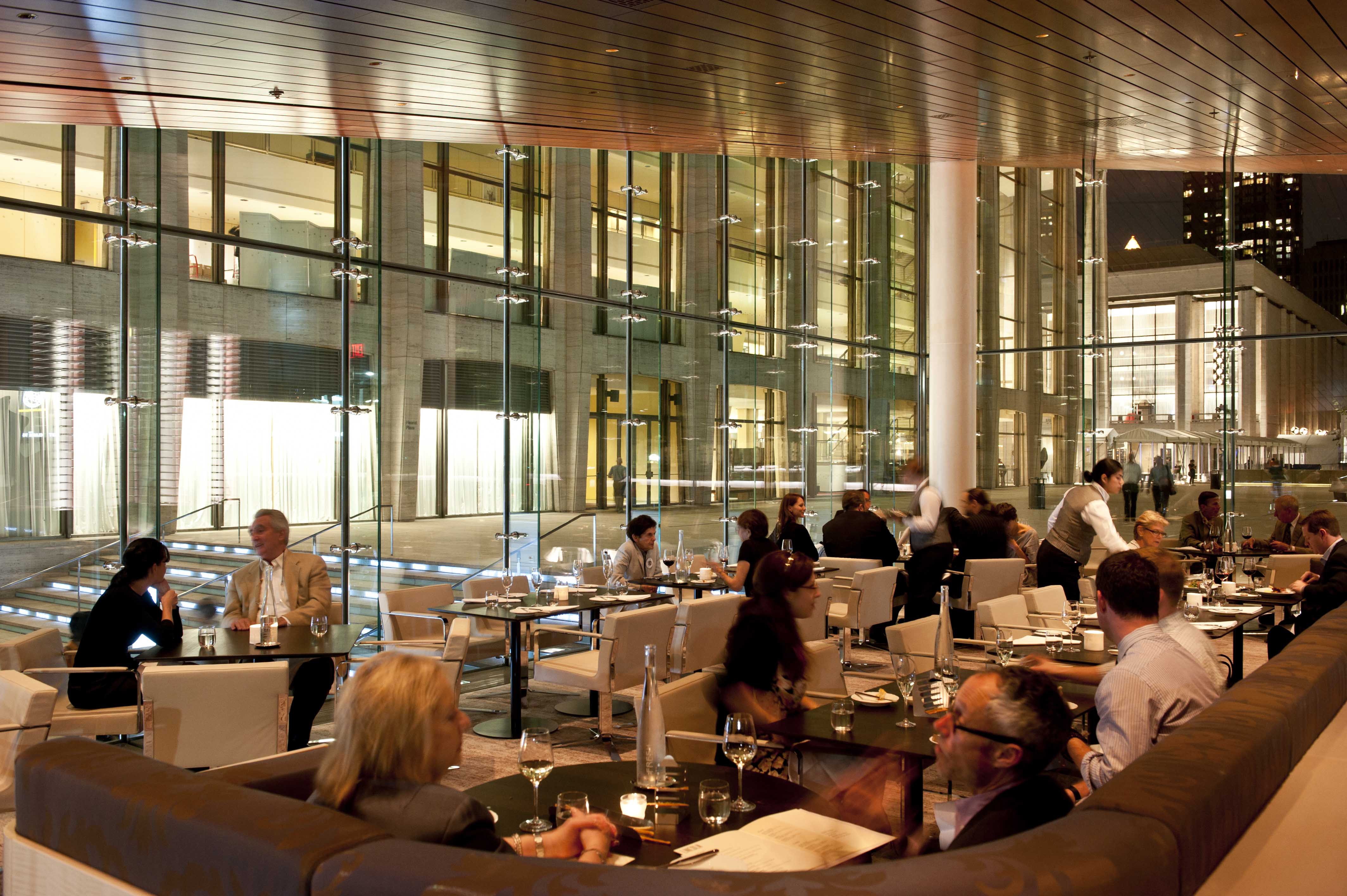
If you favor meat, the unassuming
breast of chicken
with spaetzle, watercress and baby onions is
succulent and good, while
the roast shank of braised lamb with Castelluccio
lentils and rich
sauce of lamb is a stand-out. The big veal chop (below),
requisite in NYC
Italian restaurants, is a fine one. Whatever you do,
order a side dish
of good old eggplant parmigiana: this one is
anything but
predictably good--it's one of the most delicious
items on the menu.
It
may
be
difficult
for
you
to
pass
up the splendid array of cheeses
offered here daily, with fitting wines to accompany
them, but you
definitely don't want to miss Richard Capizzi's
superb desserts, each
one with an intensity of flavor in every component,
from the warm
chocolate cake with grapefruit cream and espresso
gelato to gianduiotto
with 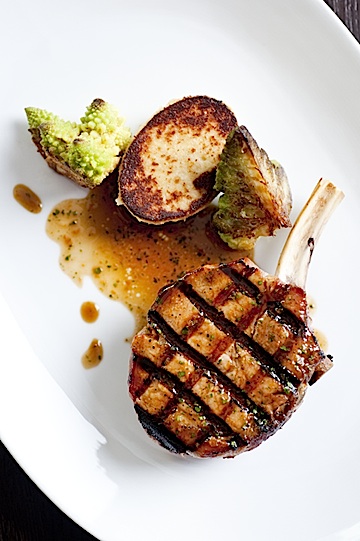 cream,
chocolate gelato, and hazelnuts, and a
marvelous crostata
of pear
and cranberry with a Muscovado sugar
and brown butter gelato.
cream,
chocolate gelato, and hazelnuts, and a
marvelous crostata
of pear
and cranberry with a Muscovado sugar
and brown butter gelato.
Early reviews remarked on
Lincoln's prices being
very high for some dishes that were then very small
in portion size,
and
that was in fact true at the beginning. But those
portions have now
been
amply expanded, so that Lincoln is no more
expensive, and in many cases
less so, than comparable NYC Italian
restaurants. For instance,
at the new Villa
Pacri in the Meat Market District, pastas run
$22-$36 and main
courses $28-$55; at
Marea, pastas are
$25-$33, main courses, $38-$49. But at Lincoln, pastas range
from $18-$28 and main courses $30-$38,
with a very well priced five-course tasting menu
$85, with wines
$55more.
At Del Posto, a similar five-course menu is $115.
Dining at Lincoln is a good deal
more than the
food and wine. Sitting there in a swiveling
chair in a
low-lighted dining room with a civilized
conversational level and a
fine
choice of unobtrusive jazz, you know you are at the
heart of something
uniquely New York, and that's
a million dollar feeling all on its own.
Lincoln
is
open
daily
for
lunch
and
dinner,
on Sat. & Sun. for brunch.
❖❖❖

MAN ABOUT TOWN
by
Christopher Mariani
Miami Style
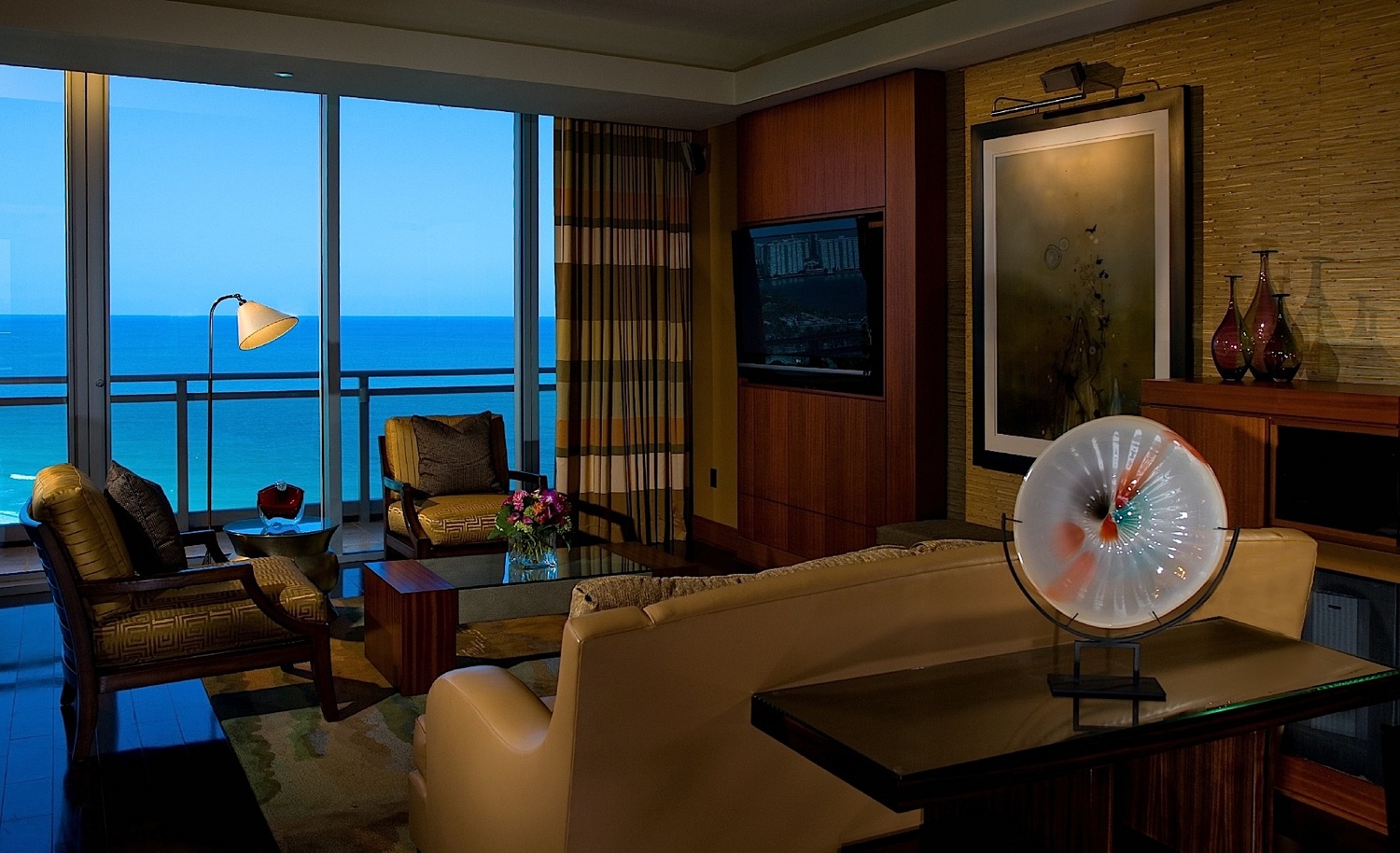 ONE
Bal
Harbor
Resort
&
Spa
ONE
Bal
Harbor
Resort
&
Spa
10295 Collins Avenue
305-455-5400
Nowadays, high-end luxury
hotels seem to be the
norm in almost every city across the United States.
Travelers can visit
any metropolis,
big or small, and will most likely have multiple hotel
options, all
with
gorgeous rooms, top-notch amenities, first-class
concierge services,
and
usually one or two really good restaurants. So what
makes one luxury
hotel stand
out from the rest? After spending many nights at some
of America’s best
hotels,
including The Ritz Carlton, The Four Seasons, The
Mandarin Oriental and
many of
Las Vegas’ finest, including the new Cosmopolitan, I
realized that
there must be a
wow factor to be considered an elite hotel in such a
saturated market
of
otherwise very good deluxe hotels.
This
past month I headed down to South Florida for a lovely
change in
climate from
the relentless and bitter cold wintry mix of NYC. Most
of the time,
depending
on the reasons for my stay in Miami, I will either
check-in at the new JW
Marriot
Marquis
Miami
for business, where I can walk right downstairs
and eat
at Daniel Boulud’s DB
Bistro
Moderne, or if for a fun weekend with
friends, the
W South Beach. But this time I needed some R&R, so
I drove north of
Miami and
checked into One
Bal Harbour Resort & Spa. At first glance,
the hotel is very
modern, with a grand lobby dressed with murals and
artwork, a very
simple yet
chic restaurant with an outside dining patio, and a
very accommodating,
friendly service staff. But it was not until I entered
my ocean view
suite that
I became really impressed, realizing this hotel had a
wow factor.
The
suites are enormous, on one side an elegantly
decorated living room (above) with dark
wood floors, yellow leather couches, a dining room
table that can seat
six, a
fully functional kitchen centered around a magnificent
marble bar, and
a direct
view of the beach that stretches as far as the eye can
see. There's a
massive
bedroom that sits on the opposing side of the suite,
where a second
balcony hangs and looks out at
the bay area through floor-to-ceiling sliding windows.
The bathroom (below)
is
almost
the same size of the bedroom, filled with a white
bathtub placed
directly next
to the window 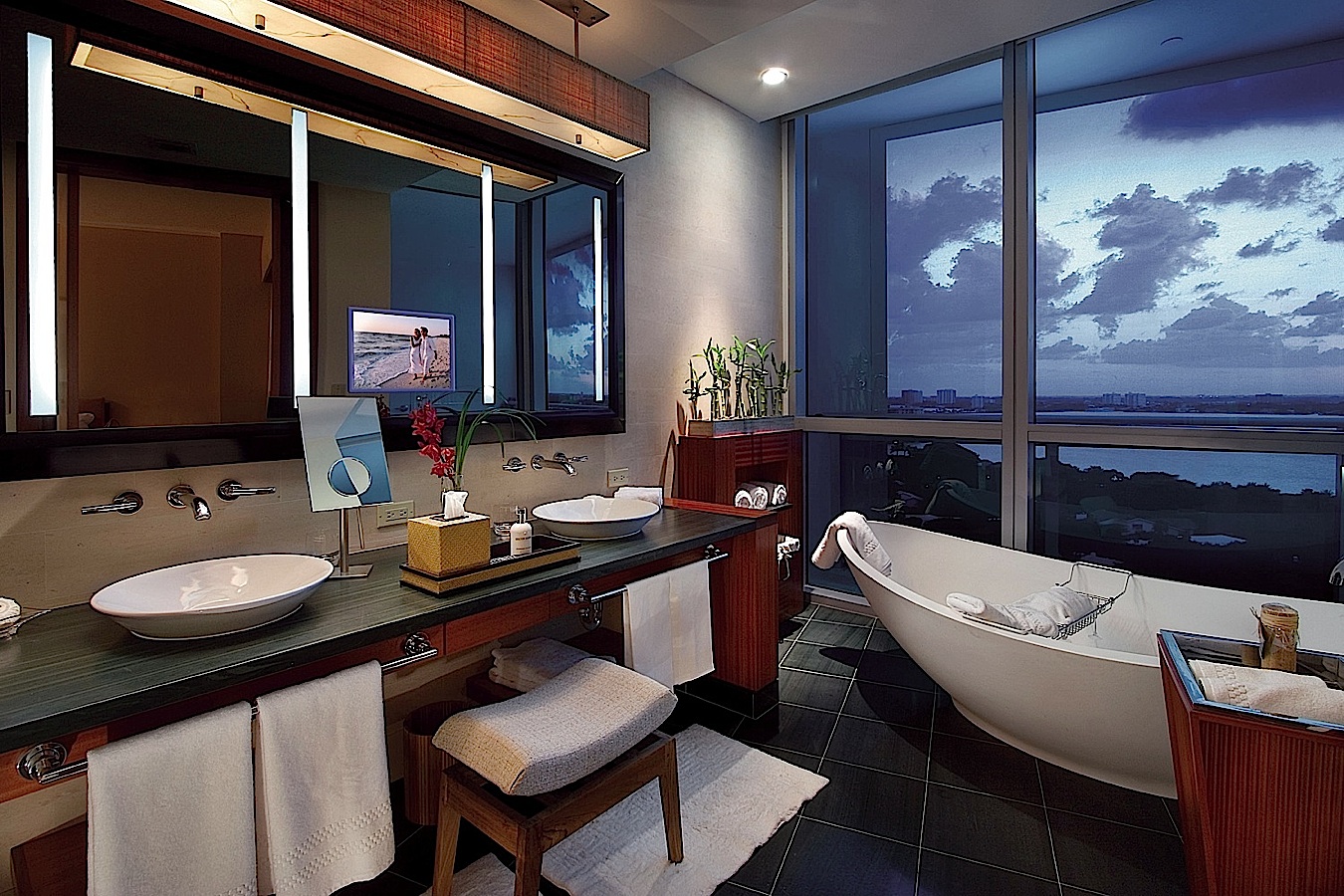 offering
a stellar view, a walk-in shower with four different
optional shower heads, and even
enough space to pull up a cot if need be. The rooms
are divided into multiple towers, so each floor has
only two rooms per
tower.
Beyond the beautifully elegant design of the suites,
it is the private
condominium feel that is unique and gratifying.
offering
a stellar view, a walk-in shower with four different
optional shower heads, and even
enough space to pull up a cot if need be. The rooms
are divided into multiple towers, so each floor has
only two rooms per
tower.
Beyond the beautifully elegant design of the suites,
it is the private
condominium feel that is unique and gratifying.
The resort also has its own private beach front with white beach chairs and umbrellas along with drink and food attendants walking with trays of Champagne and snacks. The pool area, which in the late hours of the day does not receive ample sunlight, has an attractive set up with a small bar along with a handful of personal cabanas fitted with individual hot tubs. There is one signature restaurant on property with two main dining rooms and a trendy outside terrace, wonderful for pre-dinner cocktails. There may be many hotels in the surrounding area with the same level of service of this one and an equal caliber of restaurants and amenities, but there’s definitely not a hotel that comes close to the sophistication in suite design that is found at One Bal Harbour.
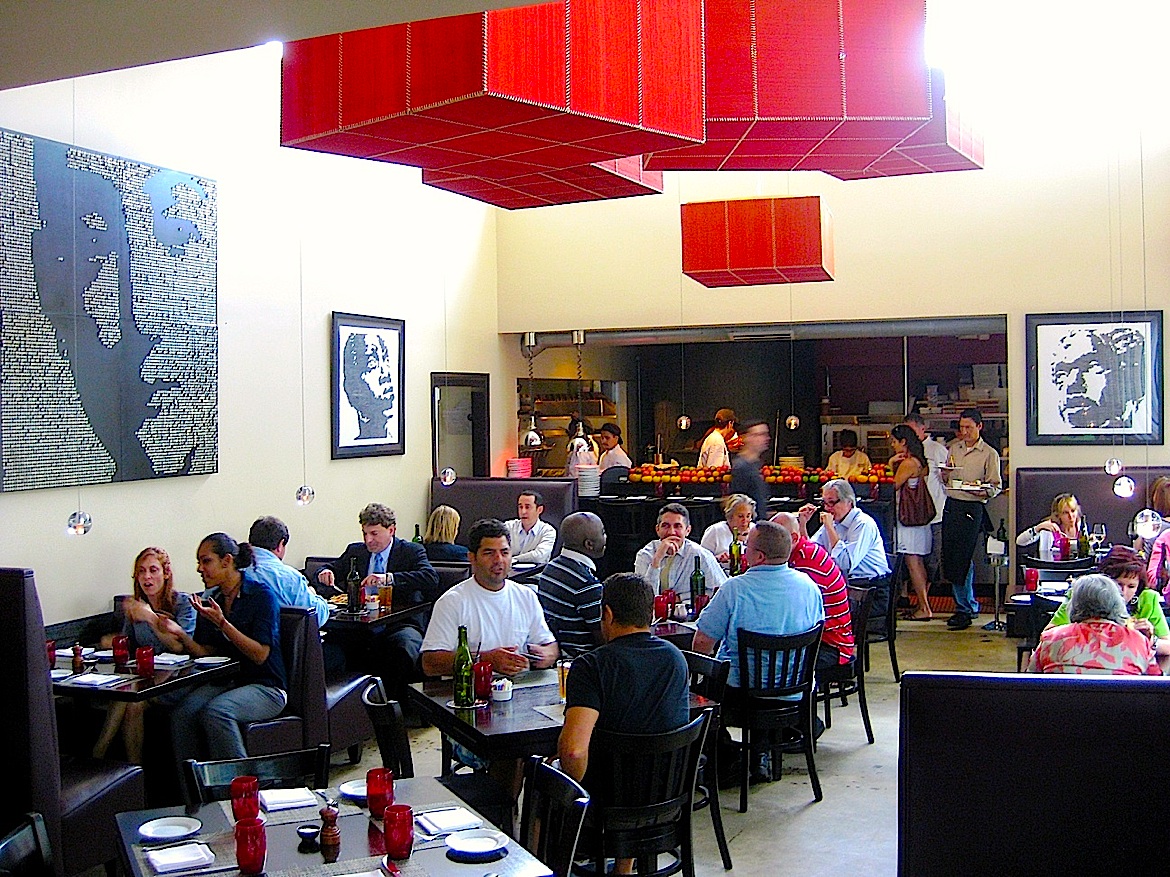 MICHAEL'S GENUINE
MICHAEL'S GENUINE
130 Northeast 40th Street
305-573-5550
About two months back I met Michael Schwartz (below) for the first time at the Cayman Cookout event on the sunny island of Grand Cayman. I did have a chance to stop by Michael’s Genuine in Cayman, but it was only for after dinner drinks from his grand selection of top shelf añejo tequilas. My first taste of Michael’s food was at a beach party the following evening, where he served sweet and spicy chunks of savory fried pork belly. Granted, I have a weakness for pork belly, but this was by far one of the best preparations I had ever tasted. So, it was without question that the next time I visited Miami I would have to stop by Michael’s Genuine and eat an entire meal.
Let
me start by saying Michael’s Genuine in Miami is
easily one of the
hottest
spots in the city. The restaurant was booming with
activity as guests
huddled
around the bar waiting for a table. The casual outside
patio was
packed, as was
the main dining room.  Reservations
are a must. The atmosphere was vibrant and
roaring with energy. Outside, diners sit around wooden
tables covered
by large
black umbrellas and enjoy a chic atmosphere while
servers bustle back
and forth
somehow maintaining a very civilized service where
drinks and food all
come out
in a timely manner. Inside, the bar is filled as
customers drink and
chat while waiting for a table. The main dining room
faces Schwartz’s
open
kitchen and is filled with dark tables and chairs,
black leather
banquets and
red water glasses that match the red spiral staircase
and hanging
art.
Because the floors are concrete and the ceilings high,
the restaurant
can get
noisy, but I guess
that’s
part of the appeal when running one of the hottest
restaurants in Miami.
Reservations
are a must. The atmosphere was vibrant and
roaring with energy. Outside, diners sit around wooden
tables covered
by large
black umbrellas and enjoy a chic atmosphere while
servers bustle back
and forth
somehow maintaining a very civilized service where
drinks and food all
come out
in a timely manner. Inside, the bar is filled as
customers drink and
chat while waiting for a table. The main dining room
faces Schwartz’s
open
kitchen and is filled with dark tables and chairs,
black leather
banquets and
red water glasses that match the red spiral staircase
and hanging
art.
Because the floors are concrete and the ceilings high,
the restaurant
can get
noisy, but I guess
that’s
part of the appeal when running one of the hottest
restaurants in Miami.
Beyond the lively atmosphere the food is why Michael’s has generated such a buzz. Schwartz’s dishes are full of gusto and the type food you want eat again and again. Flavors are bold and the ingredients taste the way they were intended too, no manipulation here. Appetizers are great for sharing and include a crispy pig's ear salad with red onions and orange slices; a terrific onion soup filled with chunks of tender beef cheek, crostini and topped with an aged Gruyère cheese. From the “medium” section of the menu, the crispy sweet and spicy pork belly is a true reflection of Schwartz’s cooking, served with a small portion of kimchi mixed with crushed peanuts and pea shoots. The menu goes on to offer an array of wood oven-roasted proteins that include a whole chicken, local snapper, Niman Ranch leg of lamb, and a well-fatted bone-in ribeye, all elegantly presented. Schwartz doesn’t stop impressing, with all desserts made in house, including a tangerine Creamsicle pot de crème; local passion fruit meringue tart; and a decadent banana toffee panino served with mint chocolate caramel ice cream
It’s too often I hear from chefs that on their rare nights off from working in the kitchen they head out for a good burger or comfort food as opposed to the type of cuisine they serve nightly. It is evident that Schwartz is cooking food he loves to cook, the type of food I can safely assume he himself would enjoy even on a night off from the stoves.
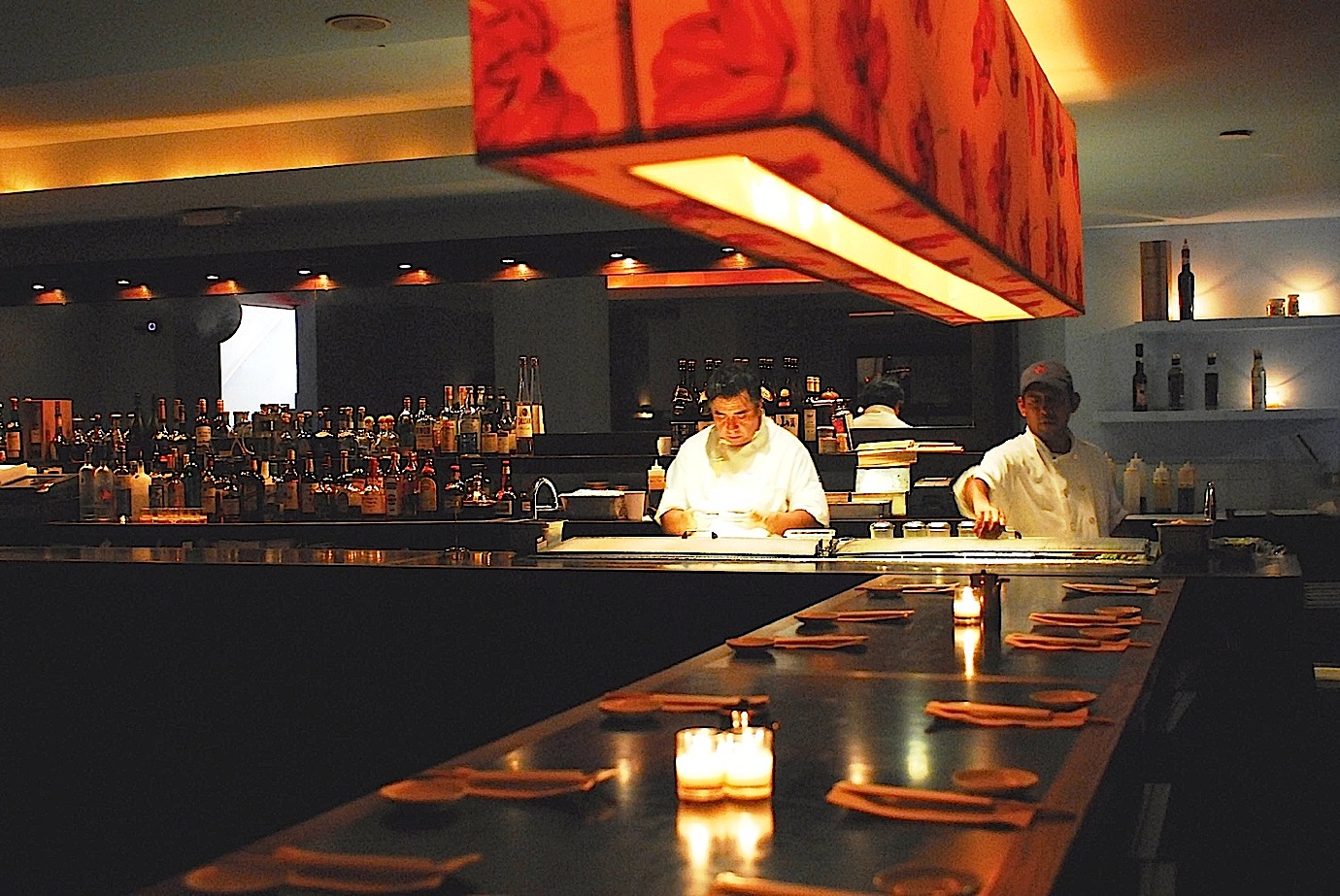 B●NDSTLOUNGE
B●NDSTLOUNGE
Inside the Townhouse Miami
150
20th Street,
Miami Beach
www.bondstrestaurant.com
Located
below
the
main
floor
of
the
Townhouse
Miami hotel is the Bond St. Lounge, a very hip
Japanese sushi
restaurant and
bar filled with young trendy guests taking shots of
sake while enjoying
house
specialty rolls, hot and cold appetizers and some
tasty teriyaki
skewers
prepared by executive chef Mike Hiraga. The dining
room has a low
ceiling and
is dimly lit creating a lounge-type ambiance. Many
tables are communal
and
diners sit together on tall chairs under low-hanging
lamps. The
atmosphere
personifies Miami’s posh lifestyle, where young men
are dressed in
light-colored
blazers and V-neck t-shirts while many of the city's
most beautiful
Cuban
women are
dressed in swanky dresses and high heels. The
attractive décor
and clientele are a good match to the beautifully
presented food. 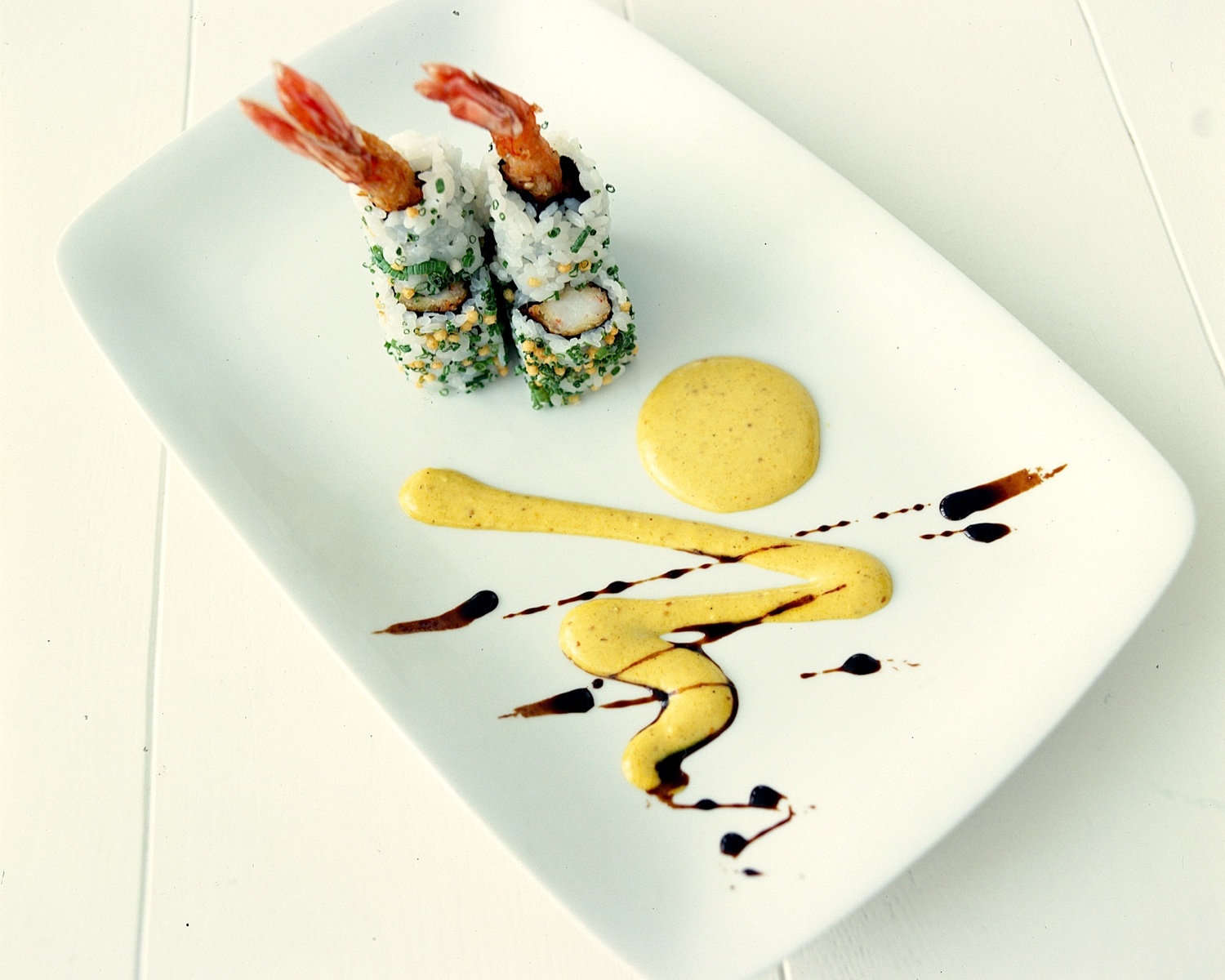
All items are reasonably priced, especially the appetizers, which include a beef tataki served over arugula and a crunchy wasabi chimichurri. Yellowtail sashimi is drizzled with a subtle Szechuan pepper ponzu sauce. Hiraga goes on to offer specialty rolls; one of the best, a simple eel tempura, is wrapped in seaweed and rice, coated with Japanese spices and sprinkled with sea salt. The smoked salmon roll is spiced up with a hint of jalapeño and balanced with a creamy dill sauce. Bond St. also features its famous premium bluefin tuna toro served in three different styles, the negiri by far the best. Generous portions of Chilean sea bass, tender beef, succulent chicken and shrimp come to table on hot skewers and can be cooked in either a teriyaki or a sweet miso glaze.
Hiraga’s
menu
is
straightforward
and
to
the
point.
He
doesn’t
pedal around and offer
every dish under the sun as so many Japanese
restaurants sometimes do.
Chef knows
his strong points and offers extremely high-end sushi
at a respectable
price.
After dining at Bond St., I was not surprised to see
the dining room
still
packed at 11 pm as late night guests were still
arriving for a few
drinks and a
quick bite.
To contact Christopher Mariani send an email to christopher@johnmariani.com
❖❖❖
NOTES
FROM
THE
WINE
CELLAR:
An Excellent 2009 Vintage Buoys Beaujolais Sales
By John Mariani
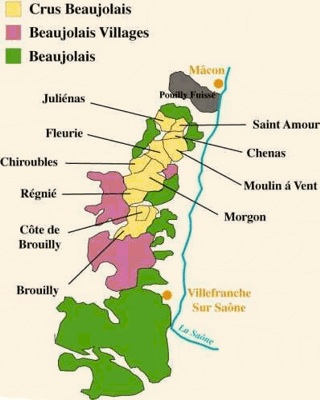 The
1970s fad for holding Beaujolais Nouveau parties
upon the November
release of
the new harvest’s wine started to fade fast in the
next decade and
really
fizzled in the next. Ever since, Beaujolais’s
reputation has been so
linked
with those unfinished, unaged wines that even wine
lovers give
relatively
little thought to well-made, well-aged non-Nouveau
Beaujolais.
The
1970s fad for holding Beaujolais Nouveau parties
upon the November
release of
the new harvest’s wine started to fade fast in the
next decade and
really
fizzled in the next. Ever since, Beaujolais’s
reputation has been so
linked
with those unfinished, unaged wines that even wine
lovers give
relatively
little thought to well-made, well-aged non-Nouveau
Beaujolais.
Indeed, after the 2001 vintage, more than 1.1 million cases of Beaujolais (mostly Nouveau) were destroyed or distilled into alcohol because of poor sales, and since then, there have been almost yearly scandals about Beaujolais being adulterated with other wines or sugar.
All of which is really too bad, because in a good year, a carefully aged Beaujolais can be sheer delight. Made from the deep purple gamay noir grape, Beaujolais is produced on hundreds of small to medium-sized properties over 50,000 acres in southern Burgundy. Most of it is sold through distributors called negoçiants. The best Beaujolais come ten village crus, whose wines are a couple of degrees higher in alcohol (13 percent and a little higher) than basic Beaujolais or Beaujolais Supérieur.
These are Brouilly, Chénas, Chiroubles, Côte de Brouilly, Fleurie, Juliènas, Moulin-à-Vent, Morgon, Saint-Amour, and Régnié—-none of which is made as Nouveau Beaujolais. All represent very good value, usually costing between $10-$15 a bottle.
The largest negoçiant, sometimes called the “King of Beaujolais” for his marketing efforts in the 1970s and 1980s, is Georges DuBouef, 77 (with his son Franck, below), who still ships 2.5 million cases annually. He himself has not escaped scandal, as when he was charged in 2005 with mixing low-grade wines into the weak 2004 harvest. Since then some U.S. wine stores have been tentative about buying Beaujolais, and one retailer I spoke with said he was offered a special deal on DuBoeuf wines but turned it down for a general lack of interest in Beaujolais on the part of his customers.
Nevertheless,
a
recent tasting of the well-regarded 2009 DuBoeuf
crus showed me that
Beaujolais can still be among the most charming
wines at the dinner
table. The
six I sampled were purchased from New York’s
Sherry-Lehmann, which,
according
to  the labels,
were “specially selected by
Georges DuBoeuf” for the
wine store.
All had been blind tasted when in barrel by the
Concours des Vins du
Maconnais
et du Beaujolais and awarded the Medaille d’Or.
the labels,
were “specially selected by
Georges DuBoeuf” for the
wine store.
All had been blind tasted when in barrel by the
Concours des Vins du
Maconnais
et du Beaujolais and awarded the Medaille d’Or.
“The ’09 vintage was so good that even the sale of Nouveau was a great success,” said Chris Adams, CEO of Sherry-Lehmann, in a phone interview. “Now, with some age, the ‘09s are so food friendly and offered at such a good price that we’re seeing interest in Beaujolais growing again.”
There
were definite distinctions among the crus I tasted
that showcased why
these
village wines generally rise above the rest. If I
may be allowed a
Gallic
metaphor, the Saint-Amour ($13.49) and the
Chénas ($12.49) were
very
feminine
compared to the heft of a Chiroubles ($12.49) and
Juliénas
($12.95). I scribbled
“gamine” on the
Saint-Amour
label, the very well-fruited cherry-like soul of
Gamay at its best, a
wine that
could be served with anything from pork to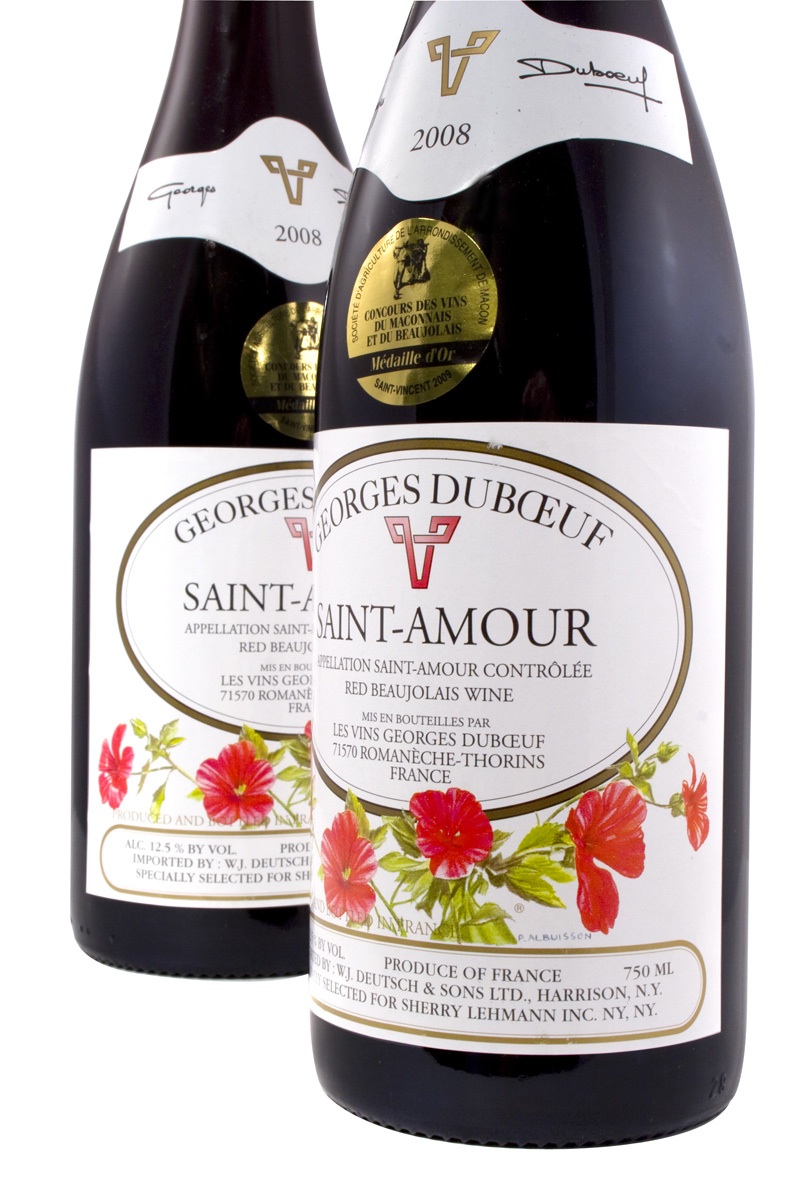 roast
chicken, which was
stuffed
under the skin with herb butter. The
Chénas—supposedly Louis
XIII's favorite
wine--was more complex
than
one might think about Beaujolais, with plenty of the
village’s ripe
fruit atop
spicy, green flavors.
roast
chicken, which was
stuffed
under the skin with herb butter. The
Chénas—supposedly Louis
XIII's favorite
wine--was more complex
than
one might think about Beaujolais, with plenty of the
village’s ripe
fruit atop
spicy, green flavors.
Another night my dinner was seared and roasted veal chops, cooked pink, and with this the Morgon ($11.95) stood out for its bold Beaujolais spirit and its ability to age well, still with soft tannins and creamy fruit flavors. A Chiroubles was the driest of my sampling, showing the minerality of its 400-meter hillside altitude and granite soil and the richness of even some mightier Burgundian pinot noirs.
I wasn’t very fond of the Juliénas, whose unimpressive, flat bouquet was followed by a one-dimensional metallic flavor I don’t think would be a match for many foods above the hamburger level. Brouilly ($12.95) is almost always a crowd pleaser, with good body, plenty of flower scents in the nose, and an earthy vibrancy of fruit that knits it all into good balance. I think it’s an ideal wine to go with grilled salmon—much better than most white wines would be—as well as terrine of foie gras on toasted country bread.
John
Mariani's wine column appears in Bloomberg
Muse News,
from
which
this
story
was
adapted.
Bloomberg
News
covers
Culture
from
art,
books,
and
theater
to
wine,
travel,
and
food
on
a
daily
basis.
❖❖❖
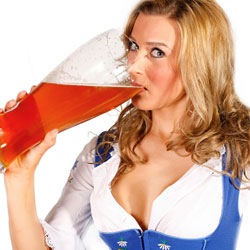 Wow, we
always thought
"Nazd'rov n'yeh!"
meant
Wow, we
always thought
"Nazd'rov n'yeh!"
meant
"How
about
a
nice
piece
of
smoked
fish?
Russia
is attempting to have beer declared an alcoholic
drink rather than
its previous designation as a food. This would allow it to be taxed by the government.
WELL,
ASIDE FROM THE DOG
FOOD, WHAT'S NOT TO LIKE?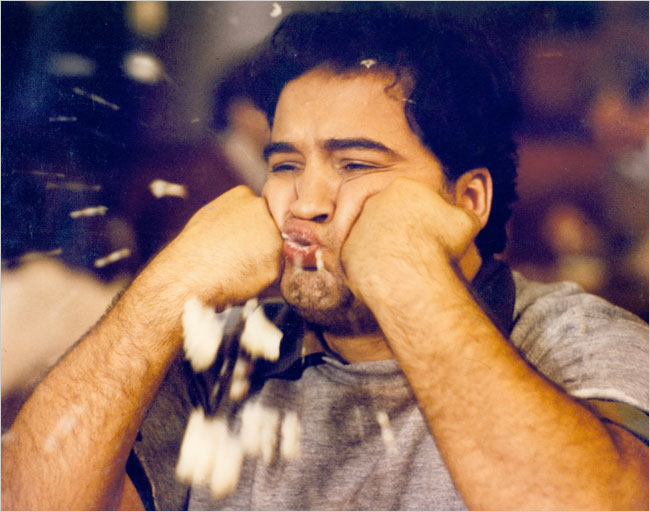
A police investigation was launched into a
possible hazing incident at the University of Virginia
after a 19-year-old
first-year student, who was
pledging at Zeta Psi fraternity, was
rushed to the hospital after eating dog food,
matzo balls, gefilte fish and soy sauce. He was
hospitalized for four
days. An
investigator said that a Zeta Psi member
said the meal is a tradition for pledges.
Quick Bytes
✉
Guidelines
for submissions: QUICK
BYTES
publishes
only events, special dinners, etc, open to the
public. When submitting
please send the
most
pertinent info, include telephone # and site, in
one short paragraph as
simple
e-mail text, WITH
DATE LISTED FIRST,
as
below.
Thanks.
John
Mariani
| From now, at Le Cirque in New York, ideeli members can enjoy a four-course, seasonal prix-fixe menu-available at Sirio Maccioni's iconic French restaurant in Midtown for $60, a savings of 34%, OR a four course prix-fixed with wine pairing for $88, also a savings of 34%. Visit www.lecirque.com |
|
Starting March 28th at Morrell & Company in New York, NY,
ideeli members can enjoy $49 for admission to "it’s
all about Napa
wines" class on Apr. 20th, 2011 or Apr. 26th, 2011—A
savings of 30%
off. Visit www.morrellwine.com |
| On Apr. 4 – 8 Michel in McLean, VA presents a special $21 three course 'model friendly' prix fixe luncheon in celebration of the Fashion for Paws runway show on Apr. 9, 2011. Healthy menu items are available to models and Michel guests alike, with a percentage of the profits benefiting The Washington Humane Society. Michel Richard will also be contributing his original artwork to the silent auction taking place during the Fashion for Paws runway show at the National Building Museum. Call 703-744-3999 or visit www.michelrichardva.com. |
On April 5 L’Auberge Chez Francois restaurant in Great Falls, VA, will host an Alsatian Wine Tasting Dinner. Owner and wine maker, Catherine Fallar, of Domain Weinbach, one of the top wineries in Alsace, will be presenting new wines and answering questions. Chef Jacques Haeringer will pair wines with a five-course meal. Price $125 per person all inclusive. To reserve spaces go to www.ChefJacques.com or call the restaurant at 703-759-3800.
|
On April 5,
Koi in Evanston,
IL, will host an
8-course chef's table led
by sushi chef Guosheng Yu. The menu will be paired
with featured wines
and sake. $35pp. Call 847-866-6969 or visit http://koi-chens.ticketleap.com/koi-april-chefs-table/ |
|
On April 6
in Larkspur,
CA, Left Bank
Brasserie hosts a “Head-To-Tail”
Suckling Pig Dinner featuring whole roasted pig with
sausage and potato
stuffing, glazed spring onions, baby carrots, and
sweet peas served
family style. $49.00 pp. Call 415-927-3331or visit www.urbantavernsf.com. |
| On April 7, Carlucci Restaurant in Downers Grove, IL, will host a winemaker reception led by Winemaker Mike Westrick of Sterling Wineries. The wines will be paired with small bites by Executive Chef Kevin Provenzano including Mozzarella con Prosciutto, Crispy Galamod and more. $25pp. Call 630-512-0990 or visit www.carluccirestaurant.com |
|
On April 9,
in San Diego,
CA, Rhythm &
Vine, A benefit for the Boys
and Girls Clubs of Greater San Diego will feature
world class wineries,
sprits, and breweries; North County's best
restaurants & gourmet
foods; and live musical performances. $75 pp/ $100
pp at the door. Call
858-866-0591 or visit www.rhythmandvine.org |
|
On April 9,
Dallis Bros.
Coffee will host the NYC
Coffee People Party,
a headline barista throwdown event for the North
East Regional Barista
Competition, in conjunction with Café Grumpy,
Joe the Art of
Coffee,
Gimme! Coffee, Third Rail Coffee, and Brooklyn
Brewery. A celebrity
panel of judges including TV personality Kelly Choi
and three-time
Brazilian barista champion Silvia Magalhaes will
oversee the latte art
competition; beer, coffee, snacks, entertainment and
entry are all free
of charge and open to the public. Visit
www.dallisbroscoffee.com. |
| On April 12, Chens Chinese and Sushi in Chicago, IL, will celebrate its 17th anniversary with a benefit for Japan. Guests will enjoy an assortment of Chinese and sushi dishes and be entered into a raffle for prizes like gift certificates, hotel stays and theater tickets. All proceeds will benefit disaster relief in Japan. $50pp. Call 773-549-9100 or visit http://koi-chens.ticketleap.com/chens-japan-benefit/ |
| On April 12, Eleven at the Loews Hotel in Atlanta, GA will host a "Corks of Burgundy" wine dinner with a focus on the wines from the house of Louis Latour. Guests will enjoy a five-course tasting menu paired with two burgundy wines for each course. The five-course dinner is $95 per person exclusive of tax and gratuity. Call 404-745-5745 or visit www.loewshotels.com/atlanta. |
| On April 13, San Francisco, CA, there's a rare opportunity to be a part of a collaboration dinner involving one of the wine world’s most renowned master sommeliers and the chef leading the soulful American cuisine movement. Sample Emmanuel Kemiji’s public and private wine library collections featuring Miura and Tejada Vineyards – featuring wines that have been out of circulation for over 10 years or never seen anywhere else - paired with Chef David Lawrence’s creative influence with the soul of southern cuisine. Wednesday, April 13, 6 pm reception, 7 pm dinner. $95 plus tax and gratuity for the reception and five-course wine pairing dinner. For reservations call 415-771-7100 or visit www.1300Fillmore.com. |
|
On April 13
in Denver, CO
The Ritz-Carlton's
signature restaurant,
ELWAY'S Downtown will host a Johnnie Walker
five-course pairing dinner
featuring a seasonal menu by ELWAY'S Chef Robert
Bogart. Attendees will
get to meet the House of Walker's Whiskey Master,
Robert Sickler.
Selected Scotch blends include Johnnie Walker Red
Label, Green Label,
Blue Label, Black Label and Gold Label. $75 pp plus
tax and gratuity.
Call 303-312-3107 or visit www.elways.com. |
| On April 13, Grotto Italian Steakhouse in Oak Brook, IL, will host a Wine and Cheese Tasting featuring Estancia Pinot Noir and Kim Crawford Sauvignon Blanc. The wines will be paired with an array of hand cut cheeses selected by Executive Chef Abraham Aguirre. Complimentary. Call 630-571-5700 or visit www.grottooakbrook.com. |
| On April 14, Chef Tony Mantuano will host Chef Jonathan Waxman for a seated dinner at Terzo Piano in Chicago in honor of Waxman's new cookbook, "Italian, My Way." Antipasti and cocktails followed by a family-style dinner with wine. Books will be available for purchase and signing with proceeds from all sales benefiting The Leukemia and Lymphoma Society of Illinois. $75 pp plus tax and gratuity. Call 312-443-8650 for reservations or visit www.terzopianochicago.com |
Any of John Mariani's books below
may be ordered from
amazon.com.
|
" A fact-filled,
entertaining history [that] substantiates its
title with hundreds of
facts in this meaty history of the rise of
Italian food culture around
the
globe. From Charles Dickens's journey through
Italy in 1844 to
20th-century
immigrants to America selling ice cream on the
streets of New Orleans,
Mariani
constantly surprises the reader with
little-known culinary anecdotes
about
Italy and its people, who have made pasta and
pizza household dishes in
the
U.S. and beyond."--Publishers Weekly
|
|
|
|
FEATURED LINKS: I am happy to report that the Virtual Gourmet is linked to four excellent travel sites:
 Everett
Potter's
Travel
Report:
Everett
Potter's
Travel
Report:
I consider this the best and savviest blog of its kind on the web. Potter is a columnist for USA Weekend, Diversion, Laptop and Luxury Spa Finder, a contributing editor for Ski and a frequent contributor to National Geographic Traveler, ForbesTraveler.com and Elle Decor. "I’ve designed this site is for people who take their travel seriously," says Potter. "For travelers who want to learn about special places but don’t necessarily want to pay through the nose for the privilege of staying there. Because at the end of the day, it’s not so much about five-star places as five-star experiences." THIS WEEK: IDAHO WHITE WATER RAFTING

❖❖❖
 Eating
Las
Vegas is the new on-line site for
Virtual Gourmet
contributor John
A. Curtas., who since 1995 has been
commenting on the Las Vegas food
scene and reviewing restaurants for Nevada
Public Radio. He is
also
the restaurant critic for KLAS TV, Channel 8
in Las Vegas, and his past
reviews can be accessed at KNPR.org.
Click
on
the
logo
below
to
go
directly
to
his
site.
Eating
Las
Vegas is the new on-line site for
Virtual Gourmet
contributor John
A. Curtas., who since 1995 has been
commenting on the Las Vegas food
scene and reviewing restaurants for Nevada
Public Radio. He is
also
the restaurant critic for KLAS TV, Channel 8
in Las Vegas, and his past
reviews can be accessed at KNPR.org.
Click
on
the
logo
below
to
go
directly
to
his
site.
Tennis Resorts Online:
A
Critical Guide to the World's
Best Tennis Resorts and Tennis Camps,
published by ROGER COX, who has spent more than two
decades writing
about tennis travel, including a 17-year stretch for Tennis magazine.
He
has
also
written
for
Arthur
Frommer's
Budget
Travel,
New
York
Magazine,
Travel
&
Leisure,
Esquire,
Money, USTA Magazine, Men's Journal, and
The Robb Report. He has
authored two books-The
World's
Best
Tennis
Vacations (Stephen
Greene
Press/Viking
Penguin,
1990)
and The
Best
Places
to
Stay
in
the
Rockies
(Houghton
Mifflin, 1992 & 1994), and the Melbourne
(Australia) chapter to the Wall
Street
Journal
Business
Guide
to
Cities
of
the
Pacific
Rim (Fodor's
Travel
Guides,
1991).

❖❖❖

The Family Travel Forum
- A
community
for those who
"Have Kids, Still Travel" and want to make family
vacations more fun,
less work and better value. FTF's travel and
parenting features,
including
reviews of tropical and ski resorts, reunion
destinations, attractions,
holiday
weekends, family festivals, cruises, and all kinds
of vacation ideas
should be
the first port of call for family vacation planners.
THIS
WEEK: TEN GREAT THEME PARKS
ALL YOU NEED BEFORE YOU GO

❖❖❖
nickonwine: An engaging, interactive wine column by Nick Passmore, Artisanal Editor, Four Seasons Magazine; Wine Columnist, BusinessWeek.com; nick@nickonwine.com; www.nickonwine.com.

❖❖❖
MARIANI'S VIRTUAL GOURMET NEWSLETTER is published weekly. Editor/Publisher: John Mariani. Contributing Writers: Christopher Mariani, Robert Mariani, John A. Curtas, Edward Brivio, Mort Hochstein, Suzanne Wright, and Brian Freedman. Contributing Photographers: Galina Stepanoff-Dargery, Bobby Pirillo. Technical Advisor: Gerry McLoughlin.
© copyright John Mariani 2011









